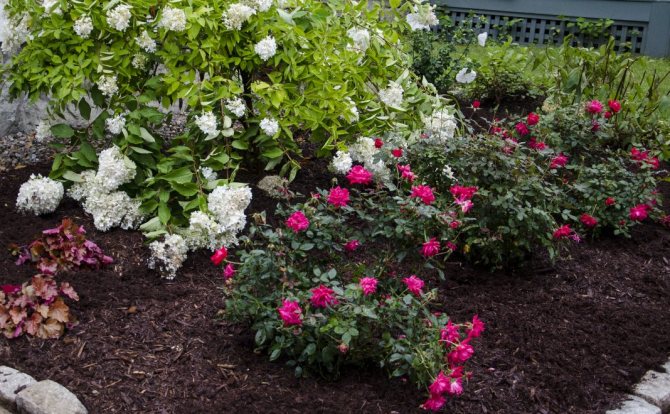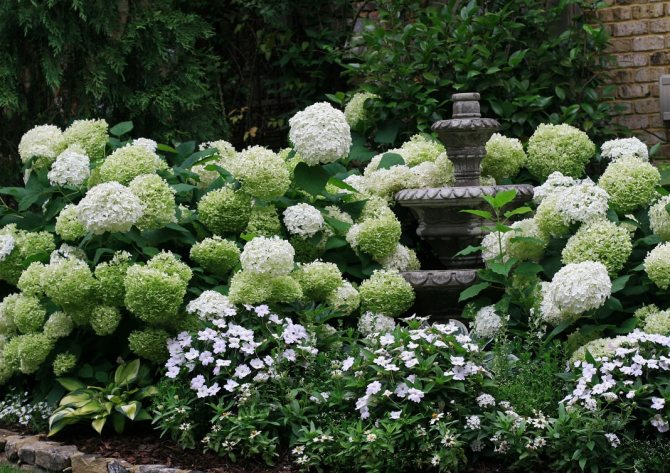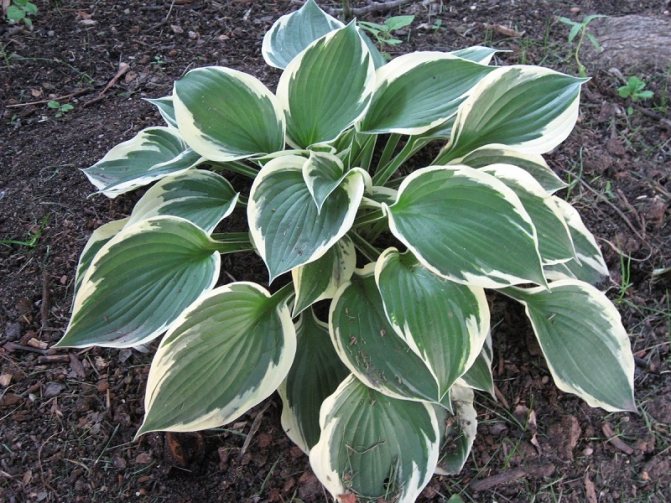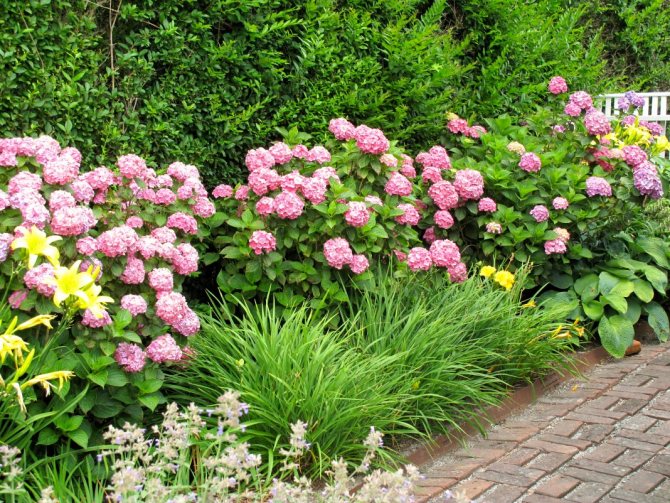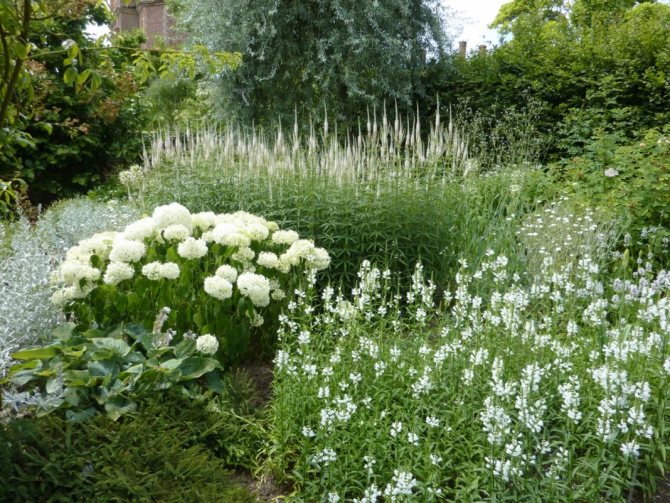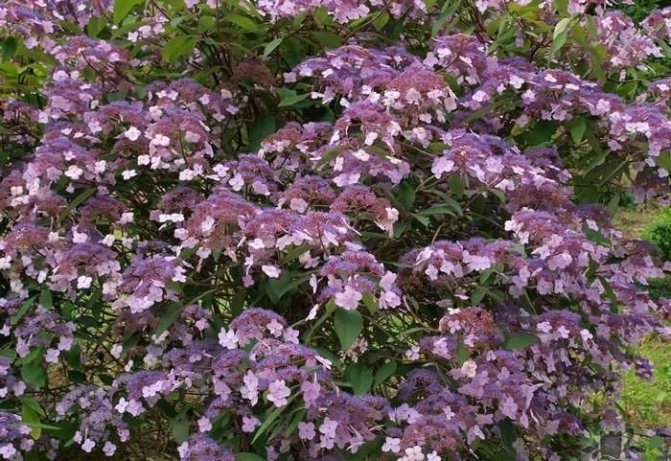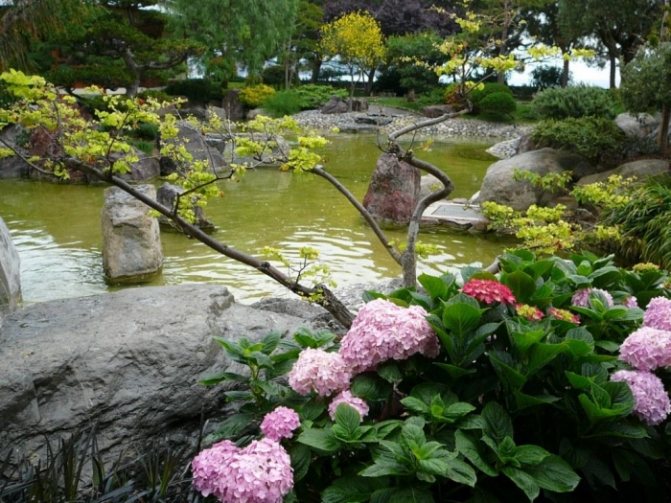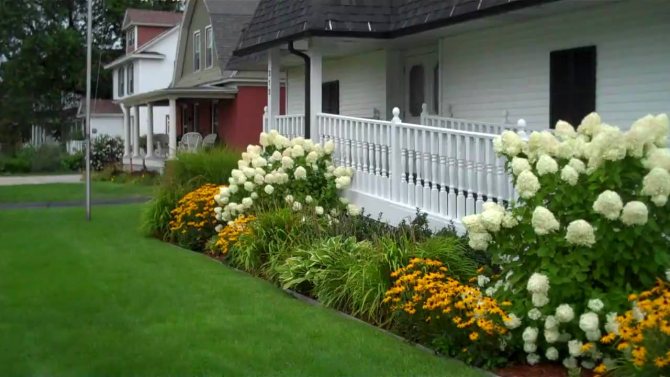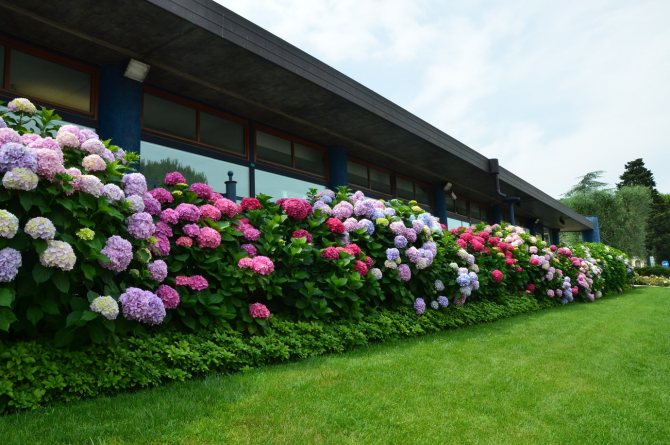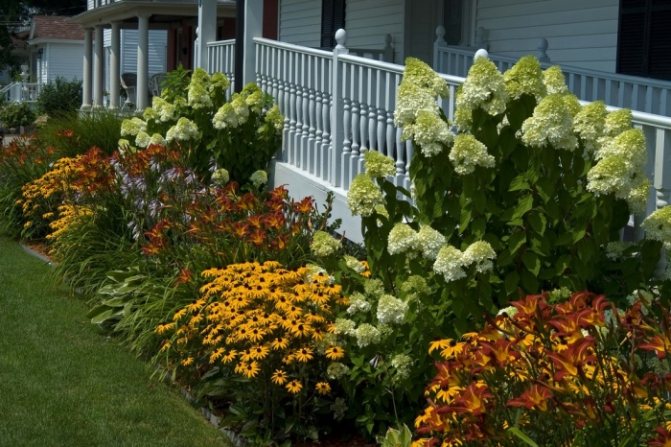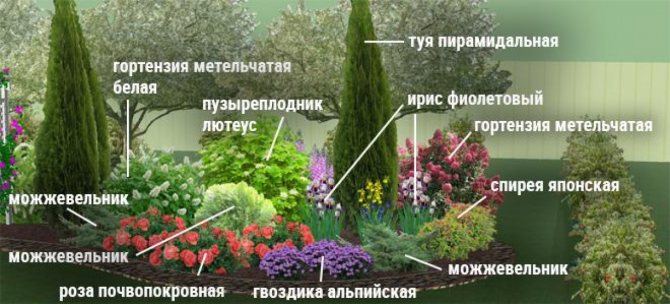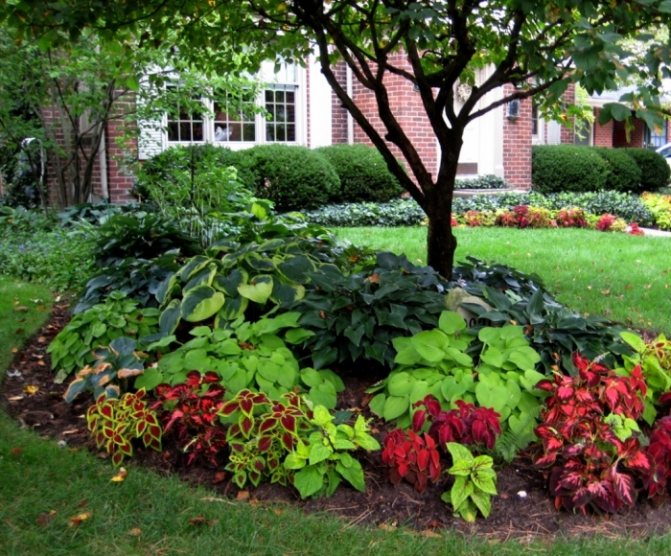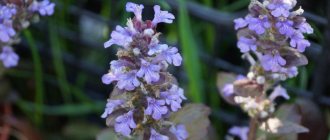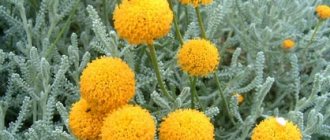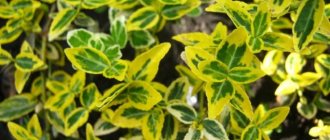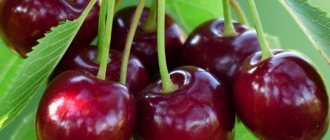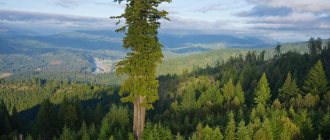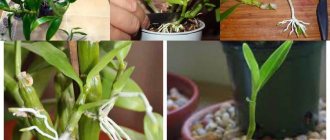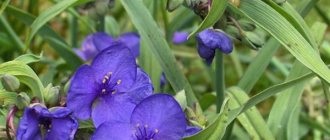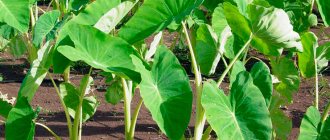Ornamental shrubs are very beautiful crops that can be used to decorate any summer cottage. There are a huge number of beautiful bushes, which allows the gardener to choose the most suitable option for himself.
Quite often, hydrangea is used in landscape design, which has a rather attractive appearance.
Photo example:

The easiest way to get a beautiful front lawn
You, of course, have seen the perfect lawn in the movies, in the alley, and possibly on the neighbor's lawn. Those who have at least once tried to grow a green area on their site will no doubt say that this is a huge work. The lawn requires careful planting, care, fertilization, watering. However, only inexperienced gardeners think so, professionals have long known about an innovative tool - liquid lawn AquaGrazz
.
There are more than 70 varieties of hydrangea. The most common types of hydrangea shrub are:
Hydrangea
The distribution of this subspecies is due to its abundant flowering and resistance to low temperatures during frosty winters.
- Treelike hydrangea is considered a shrub of small height, on average, 1-1.5 meters, it has a rounded crown, and the shoots are lowered downward.
- Leaves reach sizes from 6 to 20 cm.
- The diameter of the flower rosettes of this shrub reaches 15 cm.
- Treelike hydrangea blooms from July to October.
Treelike hydrangea is sensitive to the degree of soil fertility and moisture content, but has good resistance to frost.
Treelike hydrangea looks especially beautiful in composition with roses, lilies and clematis. A good design solution would be to use it when creating the edges.
Landscape designers have many varieties of tree hydrangea in their arsenal. We offer you a list of the most popular among them: "Annabel", "Grandiflora", "Sterilis", "HayesStarburst", "Incrediboll", "WhiteDome". The new variety, called Invincibell Spirit, is considered a real boon to decorate your garden (pictured). This hydrangea has the ability to change the color of flowers from dark pink to bright pink.
Hydrangea paniculata
Panicle hydrangea is a very common form.
- It is a large shrub that can reach up to 2.5 m in height.
- Panicle hydrangea has a rounded crown, its leaves are 10 to 12 cm long.
- Flower rosettes look like a pyramid, they are usually up to 25 cm long.
- For the first time, panicle hydrangea blooms 4 years after planting, the duration of its flowering is from June to October.
This subspecies is quite demanding on the fertility and moisture content of the soil, but it easily tolerates the conditions of existence in the city.
Like the tree hydrangea, the panicle hydrangea tolerates frosts quite easily. It is easy to turn such a hydrangea into a ball or hedge as its branches are durable and easy to form. There are many varieties of the panicle hydrangea subspecies (you can see how they look in the photo from the Internet).The most popular are the following: "Grandiflora", "Brussels Lays", "Floribunda" (abundant flowering), "Kiushu" (especially frost-hardy), "Limelight", "Matilda", "Pinky Winky", "Pink Diamond", "Unique ". An example of a hydrangea hedge in the photo.
Large-leaved hydrangea
Large-leaved hydrangea is an ornamental shrub of extraordinary beauty, which can reach a height of 1-1.5 m.
- A special feature of this hydrangea subspecies is the erect shoots.
- The leaves of the large-leaved hydrangea are simple, ovoid.
- Her flowers are sterile, have a diameter of up to 3.5 cm, their inflorescences are spherical in shape with a diameter of 20 cm.
- Large-leaved hydrangea blooms in summer (July-August).
This hydrangea has become widespread in Europe, where those varieties are most often used, the flowers of which have a variety of colors.
The large-leaved hydrangea also has two-color varieties, as well as double and lace.
A feature to remember when choosing this type of hydrangea for your garden is poor frost resistance.
Most of the trouble arises when the flower buds of the bush are preserved in winter. There is a chance that the hydrangea will not bloom next year. Therefore, you can resort to replanting the plant and storing it in cool rooms with sufficient lighting, or sheltering it to maintain it in the open ground with earth, for example.
Not so long ago, a special variety of large-leaved hydrangea was bred, which pleases its owners with continuous flowering during the summer and September. It's called Forever & Ever (pictured).
The most popular varieties of large-leaved hydrangea, according to foreign publications, are Expression (up to 60-80 cm high) and EverPeppermin (about 70 cm high).
Hydrangea petiolate or climbing
It is not for nothing that petiolate hydrangea has a second name - "climbing". It is a liana, which has suckers, with which the hydrangea is attached to the support, while growing up to 10 m. If there is no support, such a hydrangea spreads like a carpet on the ground.
- Stalked hydrangea has dark green leaves of a wide ovoid shape, about 8 cm long.
- The loose compounds of white-pink flowers of such a hydrangea have a diameter of about 20 cm. These flowers are melliferous.
- Petiolate hydrangea grows slowly and is very demanding on high soil fertility; moist loams are preferred for it.
- She calmly tolerates partial shade conditions, but you will receive abundant flowering only if you place the hydrangea in open places.
The petiolate (climbing) hydrangea can be an excellent solution for decorating the walls or balcony of your house (pictured).
Rules for the correct transplant of hydrangeas
It is better to replant hydrangea in spring. It is also best to plant young shrubs in the spring. Hydrangeas are not picky about transplanting.
The main condition is to maintain a sufficient level of soil moisture during the recovery period and when root growth occurs.
If you are forced to transplant hydrangeas out of season, then you need to get rid of some of the leaves in order to reduce the amount of moisture evaporated.
In order for the hydrangea to bloom profusely, it is necessary to remember the importance of feeding, watering, this is especially important when there is no rain. Do not allow the soil to dry out at the base of the plants.
Basically, hydrangeas prefer conditions of light partial shade and sufficient soil moisture.
There are, however, species that tolerate open sun conditions well, but at the same time require sufficient watering in hot weather. These species include treelike and panicle hydrangeas.
Fertilizers for hydrangeas should contain nitrogen in a high percentage.It is also recommended to use natural fertilizers as bait for hydrangeas, such as, for example:
- bird droppings,
- mullein,
- herbal preparations.
There are special proportions for each type of fertilizer.
How to use hydrangeas to decorate your garden
The choice of the type of hydrangea to grow in your garden depends on the climatic conditions of your area, your taste preferences and your willingness to care for capricious varieties. Hydrangea garden design solutions can be as versatile as the garden area and your imagination allow. The use of hydrangea as a single plant on the lawn will be effective, since it is a rather massive shrub. Also, such a shrub can be combined very harmoniously in compositions with other plants. Hydrangeas are often planted surrounded by a flower meadow. It is very important to use hydrangea bushes as screens or hedges. What a hedge looks like when decorated with a hydrangea, look at the photo.
It is appropriate to use hydrangeas both in the design of ceremonial grounds and in rural or natural gardens.
The goals of creating a creative design determine the choice of a particular type of hydrangea shrub for planting.
- In flower beds, for example, huge multi-colored large-leaved hydrangeas look great.
- If you want to create a romantic setting in your garden, varieties of tree and panicle hydrangeas will come to your rescue.
- For those who want to make the decor of their home or gazebo in the garden, it is better to choose the petiolate hydrangea.
Use the gifts of Mother Nature to decorate your garden. You can easily rejoice and enjoy the extraordinary beauty of hydrangea on your own personal plot.
We bring to your attention a video that will tell you more about the variety of hydrangea varieties.
Recently, hydrangea is very popular in landscape design. It will look very harmonious, especially if you use several flowers and plant them in a certain sequence.
Photo example:
Panicle hydrangea
It got its name because of the shape of the inflorescences - panicles in the shape of a pyramid. The length of such a "pyramid" reaches 25 cm. The flowers of the panicle hydrangea are of two species - bisexual and sterile. For a long time, sterile flowers stay on the branches, and bisexual flowers immediately fall off after pollination.
One bush can cover an area with a diameter of up to 2 m. For this reason, before planting a cutting, design a planting site, taking into account the fact that this variety needs space. The plant must be constantly replanted for 5 years, regular feeding is required. Do not be afraid to plant a hydrangea in the shady places of the site, because unlike other flowering plants, it takes root well in partial shade. The shrub is quite frost-resistant. Even if the frost picks up, it will quickly regain its strength and again please with its color this year. Timely watering is the main thing in caring for a shrub. Even a short-term drying out of the soil is destructive for hydrangea.
In the very name of the plant there is a Greek word - water, which indicates the preferences of the plant.


Panicle hydrangea
After planting, the first flowering will occur in 4 years. Show patience! Your anticipation will be rewarded with abundant color. It begins to bloom with white inflorescences, and ends with a rich pink.
Consider the composition of the soil before planting a paniculate species with other shrubs and trees. The plant reacts to its composition by changing color.
A slightly alkaline earth gives a pink color, and an acidic earth gives a deep blue color. This is due to a lack or absence of iron in the soil.Experts experiment with the addition of iron, different acids and get the desired shade of flowers or a combination of pink and blue flowers on the branches of the same shrub. After all the flowers have fallen off, the soft, velvety leaves will be equally attractive.
How to care for panicle hydrangea (video)
Designers use panicle hydrangea for decorative purposes for their original shape and bright color, which give the backyard a delightful look.
We list the most famous varieties of this type:
- Grandiflora (Grandiflora). Differs in cream color, which changes its shade by autumn.
- Kyushu. Airy shrub up to 3 m. Inflorescences have an openwork shape. Early flowering
- Floribunda (Floribunda). Inflorescences are creamy with dark green leaves.
- Tardiva. The conical shape of the inflorescence is white, which changes to pink and red.
- Le Vasterival. The flowers are white in the form of a propeller.
- Limelight. A unique variety, which was developed by Dutch specialists. Conical inflorescences up to 25 cm in length, lemon-colored. An interesting fact is that in the shade, the inflorescences are lemon-colored, and those planted in the sunny side of the site are white.
- Bobo (BoBo). This variety is dwarf, 50-70 cm in height. The flowers are usually white, but the color can change over time to lemon white, and later even pink.
Useful properties of hydrangea
Any garden size can be planted with beautiful and original flower varieties. For example, hydrangea. This is a small plant that embodies the spirit of antiquity. It can easily emphasize the Russian style in the garden. There is always a place for him.
This is an unpretentious plant that is often used in parks, city streets and, of course, in the gardens of private houses.
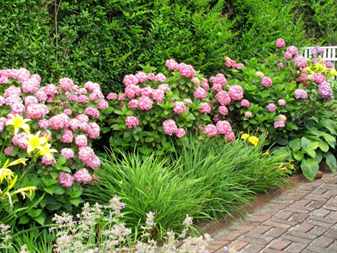

Hydrangea characteristics
The homeland of hydrangea is North America. It appeared in Europe in the XIV century and quickly gained popularity. Today there are about 70 species, mostly deciduous plants, and evergreens are also found.
In the overwhelming majority it grows in the form of shrubs of different heights - 1-3 m. There are liana-like and tree-like, growing up to 30 m. In Russia, only three species are widespread: paniculate, large-leaved and tree-like.
Flowering in all species is long - 2-3 months, inflorescences are mostly spherical white. Large-leaved varieties can have blue, red, lilac, pink color. The color of the buds depends on the acidity of the soil.
Liana hydrangeas are close relatives of the genus Schizophragma (Schizophragma). In temperate climates, the petiolate hydrangea (Hydrangea petiolaris) and the Schizophragma hydrangeoides are common.
What varieties of hydrangeas are there?
Hydrangea distinguishes several different varieties that are used by both foreign and Russian gardeners. The most popular type of hydrangea is a tree-stalked flower with white balls. They are the inflorescence.
Such a plant can be found in any garden, on a small lawn, flower bed or on the territory of a summer cottage. This plant variety is very resistant to cold winter temperatures and can be used to decorate any area.
The panicle hydrangea has the same properties. By adding it to the landscape design of the garden, the impression of airiness and tenderness is immediately created. These qualities are manifested due to the appearance of the flower, namely, conical loose inflorescences.
Both species do not need to be dug out for the winter period of time. Even for the winter, they can not be covered with anything, since they will perfectly tolerate the cool air temperature. You can plant them above the corner of the house, along the curbs or along the edge of a flower bed. Also, hydrangeas will look great in large tree beds. Photo:
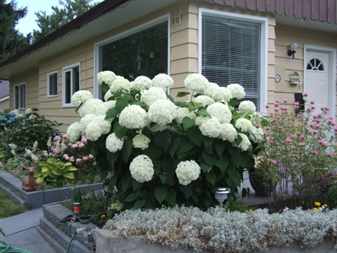

Flowerbed with hydrangea
The beauty of hydrangea (another name for hydrangea) in its inflorescences.They are in the form of a brush, a wide pyramid or a ball. Flowers are small fertile (fertile) and large sterile (sterile).
Leaves are long, round bush, reaches from 1 to 3 m in height. This determines the decorative properties of the plant and the popularity of its application in flower beds.
Planting scheme for hydrangea paniculata
If a flower garden is a limited space with many flowers, then a flower bed is an element of a flower garden.
Plants in a flower bed are not planted randomly. They form a kind of pattern, ornament, that is, they are planted according to a scheme thought out in advance.
Drawings on a flower bed are often of a geometric shape: a square, a circle, a rhombus. They require enough space to view the beauty from the outside. Therefore, not every flower garden can boast of a well-organized flower bed.
Attention! A panicle variety of a flower easily fits into the scheme of any flower bed with hydrangea.
With all the variety, flower beds are divided into several types:
- Carpet - dwarf plants with colored foliage are planted. It looks like an oriental carpet.
- Regular - all crops bloom at the same time. This is a prerequisite.
- Irregular - plants bloom in turn, one flowering wave replaces another.
- Monoclumba - flowers of the same type are planted.
Hydrangeas fit into the irregular flower bed pattern. They are arranged in front of the house.
Early spring blooms first: lacfiol, daisies, forget-me-nots. Bulbous plants (daffodils, tulips) are planted in autumn. The main accent of such a flower bed is hydrangea.
When bulbous and early spring flowers fade, they are replaced with summer-flowering annuals: Turkish carnation, zinnia, marigolds, verbena, begonia.
The freed bald spots are filled with autumn annuals and perennial flowers: pink and purple phlox, white and purple delphinium, burgundy celosia.
In the middle of the flower bed, the hydrangea remains unchanged, which literally enchants with its flowering.
What color are hydrangeas?
Modern gardeners have developed several new varieties that are becoming popular and beloved plants. They are used by almost all gardeners and simply flower lovers.
There are pink, green, white hydrangeas, and creamy flowers. All of them can be used individually and planted in a color scheme.
White hydrangea makes it possible to place and define an accent in the garden, to emphasize the season of the flower, and also such a plant will add a riot of flowering. Photo:
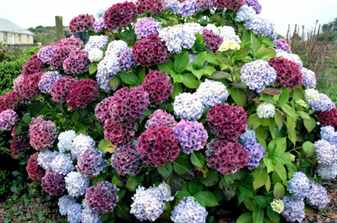

Flowering Period Information
The flowerbeds of continuous flowering transform the cottage, making the site attractive throughout the season. A key condition in drawing up schemes for such a flower bed is the regular presence of at least one flowering species. For the correct configuration of the scheme, you need to familiarize yourself with the timing of the flowering of plants:
- Warm March will delight you with snowdrops and crocuses; at the end of the month, pansies may appear in the country.
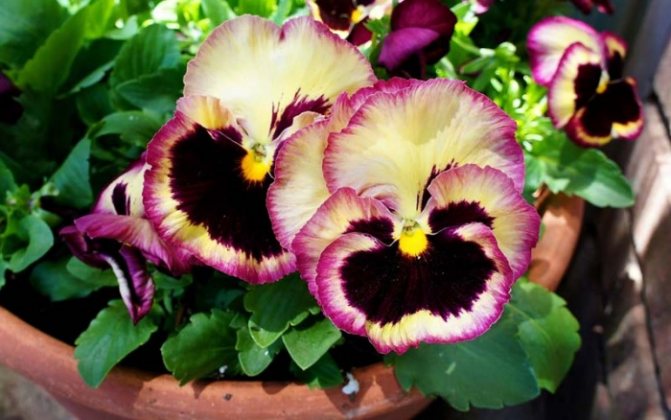

- The baton in April is taken by: lungwort, daisies, primrose, early tulips and daffodils, liverwort.
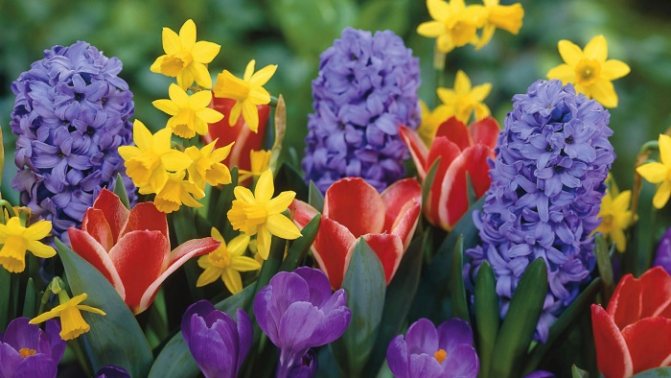

- Bulbous plants dominate the flowerbed in May: hyacinths, daffodils and tulips. In addition to them, the flower garden of the cottage will be decorated with decorative bows, lilies of the valley, phlox, forget-me-nots, a bathing suit and other types.
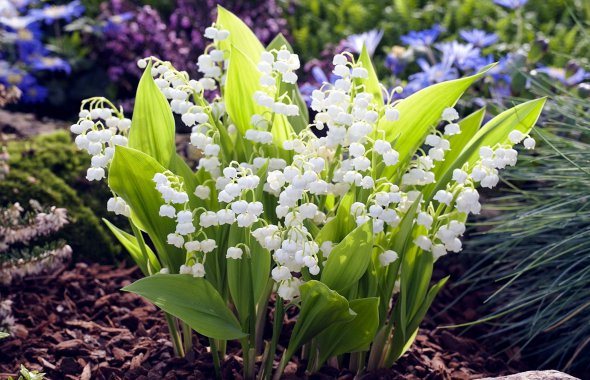

- For June, set aside a place in the flower bed scheme for carnations, peonies, daisies, bells, irises, poppies, lilies. The first summer month is generous with flowering species, a flower garden scheme for a summer cottage may contain petunias, delphiniums, irises, felicia, lupins. The first rosebuds appear, which will delight with flowers until late autumn.
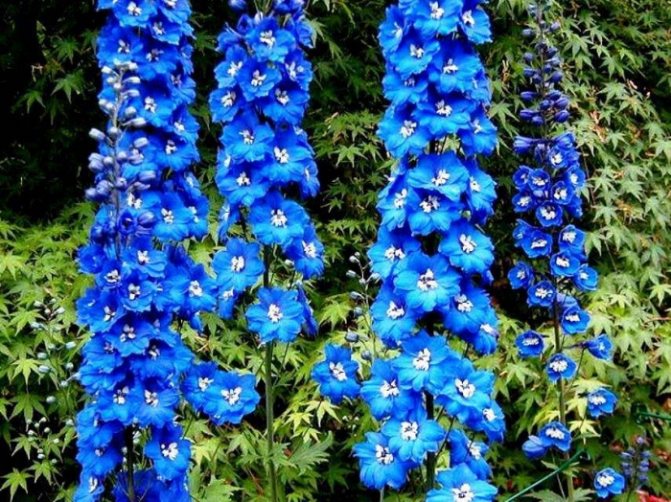

- Midsummer at the dacha will be illuminated by the flowering of daylilies, dahlias, late lilies and phlox. Cannes, nasturtium, cosmea, astilbe will organically complement the flowerbed scheme, and the evening will be filled with the heady aroma of mattiola.
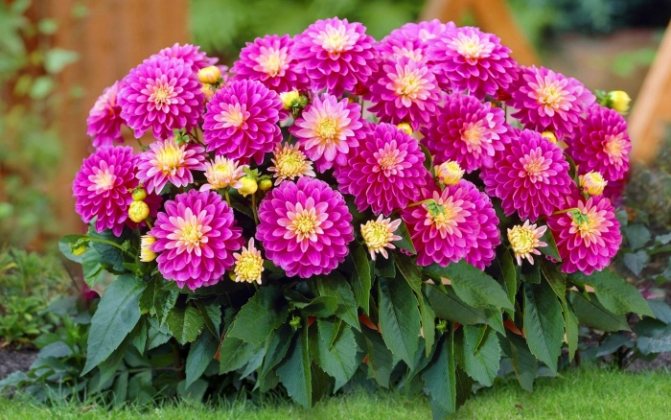

- At the end of summer, the summer cottage continues to be decorated with a flower garden with dahlias, phloxes and astilba, passing the baton to summer chrysanthemums, gladioli, ornamental sunflowers and goldenrod.


- For September, set aside a place in the flower bed scheme for marigolds, asters, dahlias and chrysanthemums. If you're lucky, daisies, pansies and hybrid roses will bloom a second time.
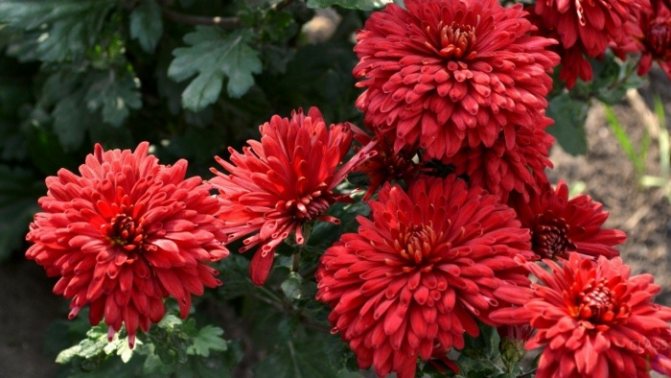

- A stunning spring landscape in the country is depicted in the following flower garden diagram, which includes an apple tree, viburnum, clematis, action, bell and veronica.
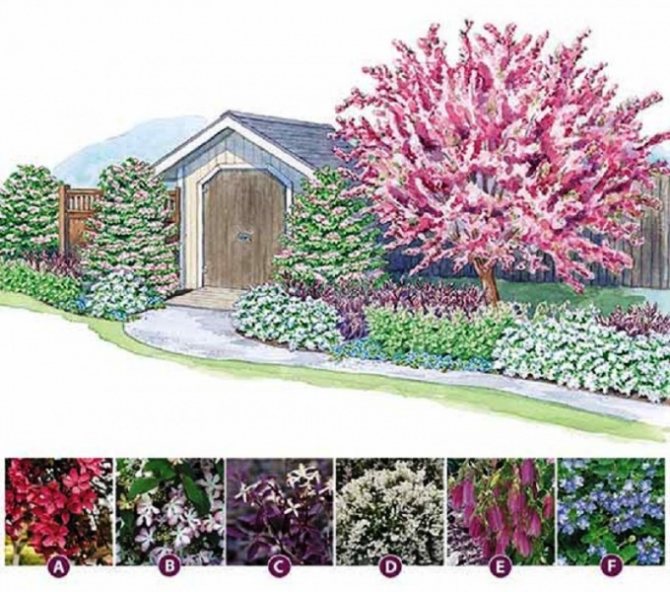

- For the improvement of the path to the garden, you can choose a flower bed scheme of juniper, mountaineer, sage, cinquefoil, helenium and formium.
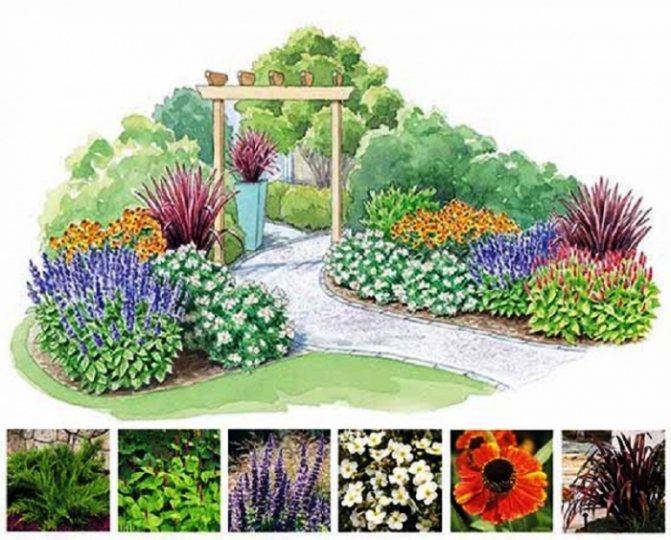

What plants and flowers does hydrangea combine with?
Hydrangea can be successfully planted with other varieties and types of plants. You can safely plant it with mock orange, lilac and spirea
.
The inflorescence can be in the form of a cap, umbrella or panicle. Each of this type will emphasize the style and beauty of the garden, its landscape design.
The spire is often trimmed, so it looks crisp. And next to it, an overgrown hydrangea bush will look natural and harmonious. Planting the plant in a quiet place where there will be no strong wind will serve as additional protection for such a plant.


Hydrangea: description and features of the plant
The genus of hydrangea has more than a hundred different species, but they all have characteristic features. The leaves of this plant are large, oval, even somewhat ovoid, with pointed or wavy edges.
Many inflorescences are lush bunches, most often formed into a spherical shape. But there are also inflorescences in the form of an umbrella, panicle, ball or cone. Inflorescences can reach about 10-25cm in diameter, depending on the variety.
Hydrangea flowers can be any shade of pink, white, blue or lilac. At the same time, it is possible to combine a palette of two colors on one inflorescence, which looks very picturesque. The color of the inflorescences strongly depends on the soil: on alkaline soils, hydrangeas bloom pink inflorescences, and on acid soils, blue ones. You can also change the color of a flower artificially, enriching the soil with the necessary elements.
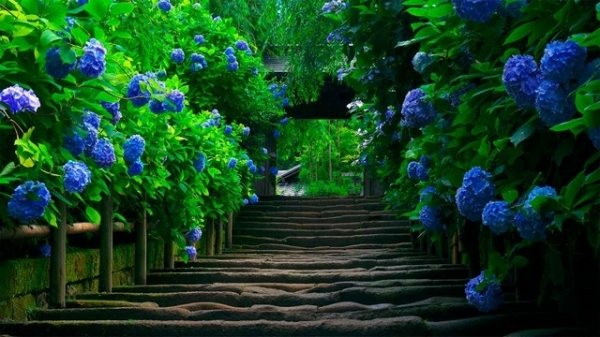

Hydrangea in the garden blue
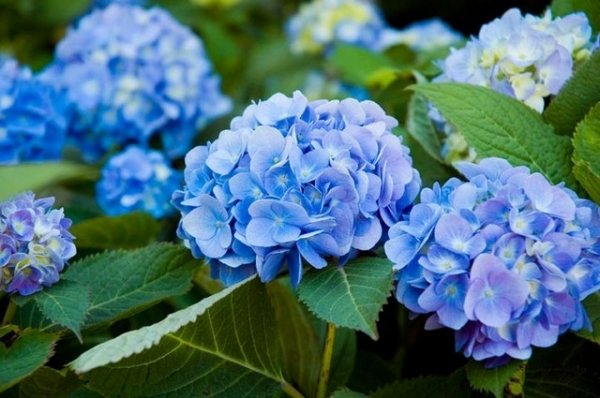

Hydrangea blue photo
Digging and cleaning for the winter
Hydrangea needs to be cultivated, especially in the fall. If the flower is still young, then it is better to dig it up for the winter and put it in a basement or a non-ventilated garage.
The most dangerous phenomenon for such a flower is a draft, so such places should be avoided.
Do you want to decorate your garden with an unusual shrub? Try planting a hydrangea flower, planting and caring for which in the open field is simple, reproduction and growing of hydrangea is possible even for novice gardeners. You can find a fantastically beautiful flower by reading the description of the variety and considering its combination with other plants in landscape design. In the photo, the hydrangea looks like the queen of the garden.
Hydrangea Garden Decorating Ideas
You need to choose a variety of hydrangeas in accordance with your own preferences, financial capabilities and, of course, the area of the site.
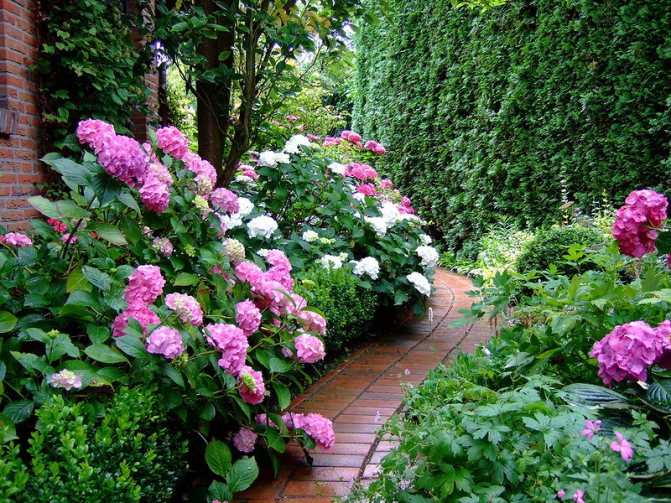

You need to choose a variety of hydrangeas in accordance with your own preferences.
Connoisseurs of minimalism will love the option of a flat green lawn with a bright volumetric accent in the middle. In landscape design, thuja and hydrangeas are often used together to create volumetric living elements; photos of examples of such use can be easily found on the Internet. These shrubs are quite massive and voluminous, so even single plants look very impressive.


Hydrangea with lilies in landscape design looks interesting
Hydrangeas look no less interesting in combination with other plants.So, tree hydrangea can become an excellent partner for lilacs or any other flowering plant, since it replaces them in bloom and does not allow the garden to become boring.
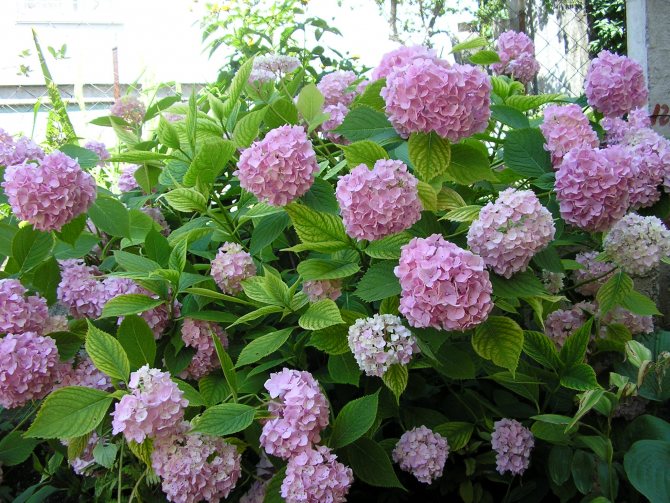

Hydrangeas in landscape design are almost universal.
Hydrangeas are often surrounded by a floral arrangement. They are good in combination with lilies, mock orange, rose, spirea. The advantage in this case will be that they will allow you to create a transition between flowering spring plants and autumn asters, dahlias.
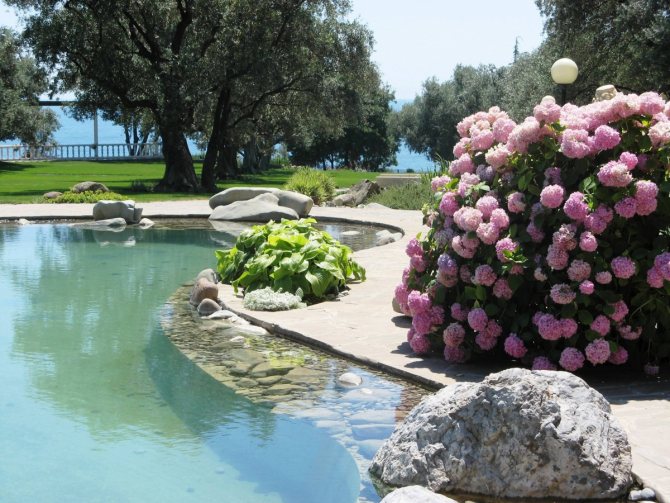

The choice of the type of shrub is determined by the purpose and location of the composition.
Hydrangeas are also good because they are almost universal: they are suitable for decorating parks and ceremonial grounds, city gardens and arboretums, and even rural front gardens.
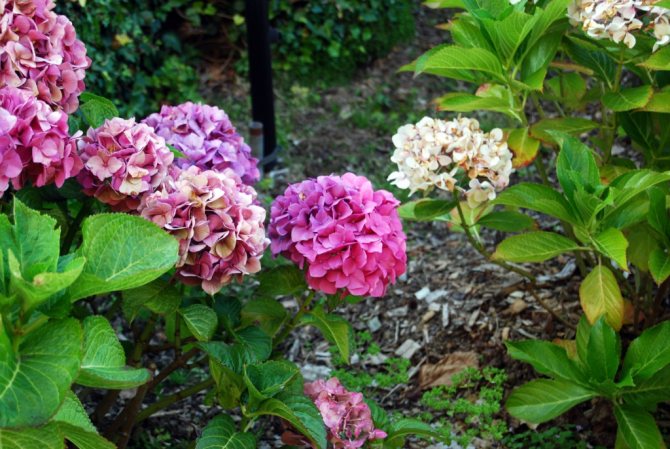

Hydrangea tree-like will give a romantic atmosphere
The choice of the type of shrub is determined by the purpose and location of the composition. Low-growing varieties of hydrangea, with long leaves and inflorescences of different colors, are perfect for a flower bed.
To give the garden a romantic atmosphere, the tree hydrangea is usually used in landscape design; examples of the use of this plant species can be seen in the photos, which are posted in large numbers on specialized design sites.


Hydrangeas can give a window a nice look
If there is a body of water on the site, hydrangea can become the main element of the decor of the coastal area. For such compositions, designers recommend using tree and paniculate species. You can supplement the composition with astilba, hosta or badan, you can also plant any other moisture-loving flowers. The advantage of this decoration method is that after the end of the flowering period, the composition will look good due to the variety of leaf plates.


Hydrangeas are also successfully used in vertical gardening.
Hydrangeas are also successfully used in vertical gardening. You can decorate the facade of the building with the help of another type of hydrangea - curly. It looks most impressive, of course, in the summer, during the flowering period. But in late autumn it looks good due to the multi-colored foliage. In winter, when the leaves and trunk are covered with frost, the view becomes more spectacular, responding to the atmosphere of the winter garden.
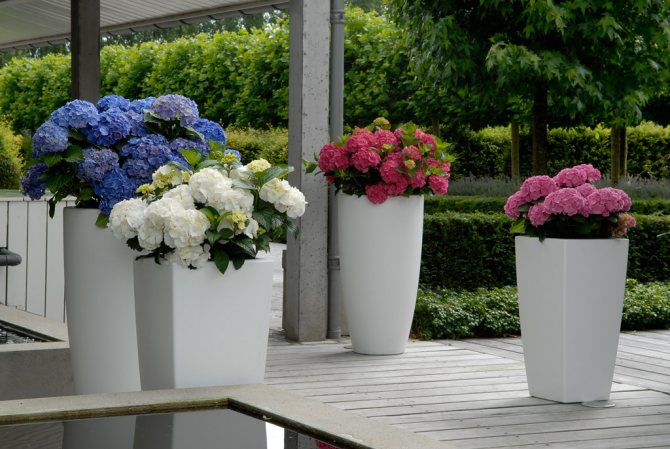

Can accommodate low-growing hydrangeas in brightly colored containers or flower pots
Varieties and varieties of hydrangea
Hydrangea is an undoubted favorite among flowers in summer cottages. A long flowering period, a variety of shapes and tones attract special attention to it from gardeners and designers; more and more often, various varieties of this perennial are used in landscape design.
Hydrangeas can be spherical, racemose, and white, lilac, red, two-colored in color. The most common in our latitudes is the tree hydrangea. Unpretentious, fairly easy to care for and grow, the plant is recommended for novice gardeners. Several varieties of shrubs have been bred by breeders:
- Bella Anna
- a new variety of tree hydrangea, has rather large spherical inflorescences, the crown grows up to three meters in diameter, the color of the petals is from pale pink to purple-pink, blooms throughout the summer season and September;
- "Anabel"
- a lush blooming, spreading shrub about 1.5 m high, inflorescences in the form of a ball of snow-white color, blooms in early July and retains color throughout the summer season until September. After flowering, the leaves of the plant remain bright green throughout the fall. Variety "Anabel" is adapted for wintering, does not require special shelter for the winter, frost-resistant;
- "Grandiflora"
- differs in large crystal-white inflorescences, blooms for 4 months;
- "Invincibel Spirit"
- a new variety of hydrangea with pink petals;
- "Sterilis"
- a variety with hemispherical, dense, heavy inflorescences, during the flowering period - from July to October - the petals radically change color: from pale green to crystal white.
Also, a fairly common perennial variety - Panicle hydrangea, planting and caring for which is quite simple. This flower is attractive with inflorescences of an unusual - paniculate - shape, frost-resistant, characterized by rapid recovery even in unfavorable climatic conditions. An interesting feature of this hydrangea variety is the particularly long flowering period, during which the inflorescence changes its color. Does not need mulching for the winter. The most common varieties of panicle hydrangea are:
- Vanilla Fraze
- variety with pale white and pink petals;
- "Limelight"
- the plant blooms in autumn, differs in large inflorescences of a pale lemon shade;
- "Pinky Winky"
- hydrangea with soft red petals.
The mysterious homeland of Hortense
An exquisite garden hydrangea that loves warmth and water has arrived to us from the mysterious land of the rising sun. This plant originally had its distribution area in southern Japan, China and was found both in the Himalayas and on both American continents. Hydrangea was brought from Japan to France at the end of the 19th century, and since 1970 this plant has been cultivated and widely used in landscape design. By presenting hydrangea flowers, people who know the language of flowers could express indifference, inflexibility and lack of feelings to the donee. However, there is another interpretation - "yours forever."
The Greek name for the plant is hydrangia, it combines the meanings of two words: water and vessel. The name is justified by the flower's increased love for moisture and the specific shape of the seed capsule.
How to plant correctly
Growing hydrangeas in the open field is possible even for novice gardeners. If a hydrangea is chosen for a flower garden, planting and caring for it will never be a burden, they will become favorite activities. The correct location should be chosen for planting the shrub. Hydrangea does not tolerate long shading, the best place to plant it is on the sunny side. Hydrangea propagation is carried out by separate bushes or cuttings. It is recommended to plant a flower in spring (in May) or in autumn (in warm September).
To plant a hydrangea with a bush in the open ground, you need to dig a planting hole about 60 cm deep, about half a meter wide and long. The distance between the bushes is at least 1.5 meters. A flower, growing with proper care, will occupy a much larger area than when planted. The pits should be filled with a special mixture, including peat, sand, soil, humus (1: 1: 2: 2) and fertilizers (landscape design experts recommend combining 20 g of urea, potassium sulphide each, add about 60 g of superphosphate in granules and 10 kg of humus ).
Attention: do not add lime to the soil mixture for hydrangea - it is detrimental to this plant.
When planting, it should be borne in mind that the root collar of the plant should be at ground level. After planting the hydrangea in open ground, it must be watered abundantly.
Flower bed preparation
To calculate the required number of seedlings, the flower garden scheme is divided into squares with a conditional side of 1 m.After that, the area occupied by each species is calculated. The resulting value is divided by the average planting rate per 1 m 2:
- large stands with a height of 1.0-1.2 m - 2-3 pcs.;
- medium-sized flowers from 40 to 90 cm high, 4-6 pieces are enough;
- at a plant height of 20-40 cm, 7-9 specimens are planted in a flower garden per 1 m 2;
- for dwarf flowers from 5 to 20 cm, the norm is 16-20 pcs.
To transfer the flower bed scheme to the dacha site, the contours of the planting are marked with sawdust, sand or chalk. Before that, the earth is dug to a depth of 0.4 m, all weed roots and the top layer of sod are removed.Specially prepared soil is poured on top for the flower garden.
An example of a successful decoration of the entrance to the dacha is presented in the following diagram, where roses, petunias, thuja, delphinium, lilies, asters and a cuff are used in the design of the flower beds:
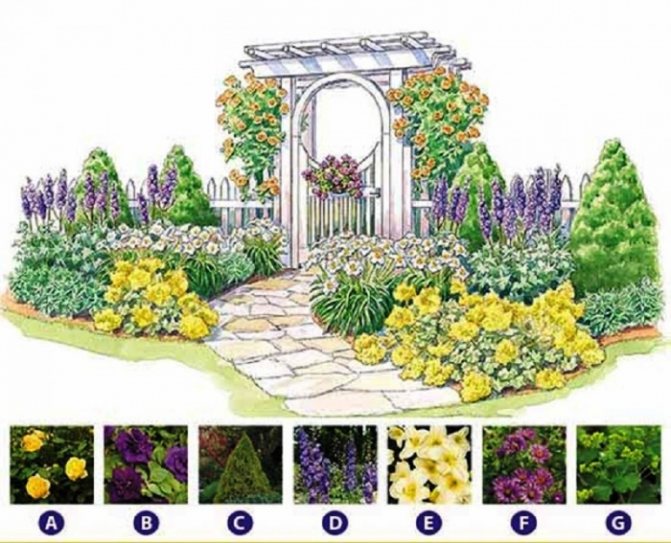

Suitable care
Hydrangea care consists in weeding and loosening the soil around it, organizing a timely and correct irrigation regime. In addition, to prevent rapid evaporation of moisture, it is recommended to mulch the bush in early summer with peat or sawdust.
A perennial needs proper pruning. The plant should be pruned in the spring before the beginning of the growing season, removing old shoots and leaving young and strong ones, shortening them by 3-5 buds. Faded and dried bush inflorescences must be removed. Old perennial bushes must be cut almost at the root, leaving only low stumps, from which young shoots will develop.
Hydrangea care: from planting to flowering
All recommendations indicating how to care for hydrangea boil down to just two steps: fertilizing and pruning the plant. It is this kind of care that is quite sufficient for the beautiful hydrangea to delight you with a healthy look and beautiful flowers. But before you start caring for the garden hydrangea, it would be nice to plant it.
Reproduction
The breeding process of hydrangeas occurs either through green cuttings or by dividing the bush. In spring and summer, you can use the non-flowering green tops of the shoots; in the cold period, woody cuttings will come off.
Do not forget that hydrangeas also have seeds: species of plants can be sown in an unheated greenhouse in spring.
Landing
Hydrangea, planting and caring for which is very easy, still requires attention. In mid-latitudes, it is better to plant this thermophilic plant in spring, and in more southern regions in spring and autumn. Leave about a meter between the plants.
The soil
It is better to grow hydrangeas in the garden on moisture-permeable, structural soils, loamy and flavored with organic matter. It is better to give the choice of soil to neutral or acidic options. Despite its beautiful pink color, alkaline soils above pH7 are unfavorable for plants, hydrangea begins to experience iron deficiency and becomes sick. Using iron, alum, sulfur, or aluminum sulfate, you can play with the color of the plant to achieve a variety of colors: pink, blue, bicolor buds, or even bushes with flowers of both colors.
Pruning
To eliminate misunderstandings, it is immediately worth noting: garden hydrangea is not cut by the root! By pruning, to which all plant varieties respond well, it is precisely the rejuvenation of the shoots that is meant.
In mild climates, the procedure for removing old inflorescences should be done not in autumn, but in early spring. It is necessary that the pruning of the hydrangea in the spring falls before the beginning of the active growing season.
First, the frozen shoots are cut to a healthy part of the wood, and weak or excessive shoots are completely removed. Annual shoots should be cut off, leaving about 3-5 buds on them. Old inflorescences are removed before the first pair of healthy and strong buds.
Wintering
Those who already have a hydrangea in the country know: this plant needs a reliable shelter during the cold weather. The flower will endure this period better if the soil is moist in the fall. Hydrangea is very sensitive to any frost, so it is worth taking care of shelter in early October.
Watering
Hydrangea loves water and needs at least two buckets of water a week. In rainy weather or when using mulch, one watering per month is sufficient.


Hydrangea garden planting and care
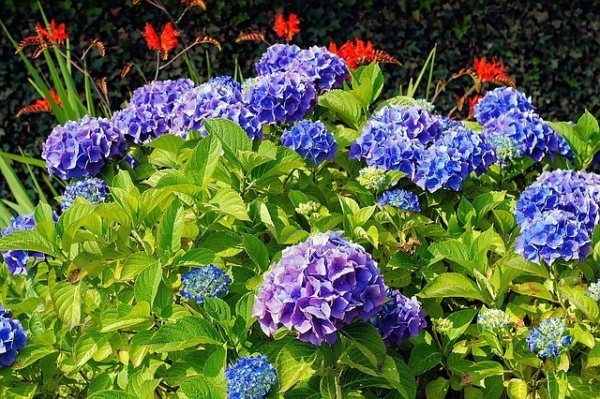

How to care for hydrangea
With good and careful care, the garden hydrangea will delight your eye with its luxurious splendor for more than one year!
Fertilizing and fertilizing hydrangeas
The hydrangea planted in prepared and fertilized soil for the first two years can not be fertilized or fed. Then the procedure for feeding hydrangeas is as follows:
- in the spring, it is necessary to apply a complex fertilizer containing micro- and macroelements (phosphorus, potassium, nitrogen) under each bush;
- the second time in a season, top dressing (potassium sulfate together with superphosphate) is applied during the period when buds appear on the bush;
- a couple of times it is advisable to feed the perennial with diluted chicken droppings or cow dung.
Caution: Excessive fertilization of nitrogen can lead to greening of hydrangea petals and problems with wintering of the plant.
It should also be borne in mind that hydrangea responds well to lactic acid, therefore it is important when growing it to periodically water the bush with soaked sour bread, milk whey, sour milk, kefir.
Design Tips
In addition to the flowering period, when forming a flower garden scheme for a summer cottage, the requirements of plants for soil acidity, lighting conditions, and also their height are taken into account.
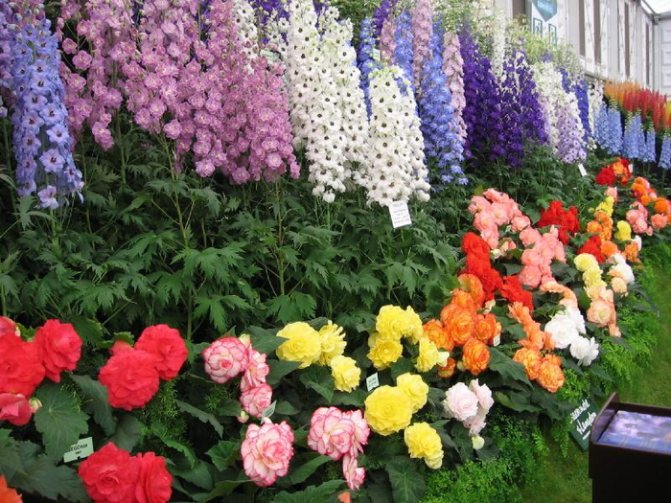

The group of low-growing plants contains unpretentious bulbous specimens: hyacinths, snowdrops, crocuses and muscari. For beginners, as perennials for a flower bed scheme, you can advise felt chickweed, subulate phlox and primrose. The dacha will also be decorated with bright biennials in the form of daisies, forget-me-nots and pansies. Annual representatives of the flora in the form of undersized marigolds, petunias, purslane are able to organically complement the flower garden scheme.
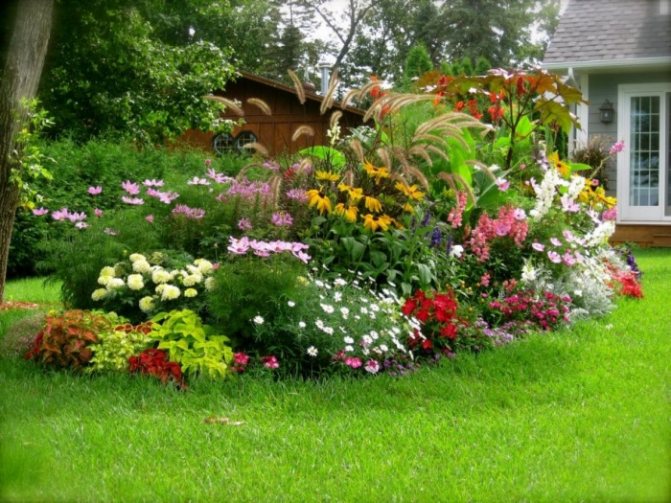

Flowers of medium height are the basic basis of a flower garden in a summer cottage, therefore, for the scheme, it is preferable to choose specimens with a special decorative effect. These conditions are met by such perennials:
Annual species will help to fill the voids in a new flowerbed in the country: marigolds, asters, lavatera and salvia. In the background or in the center of the flower bed, a place for tall plants is assigned in the scheme. For these purposes, aconite, ornamental sunflower, clary sage, delphinium, lupine are suitable.
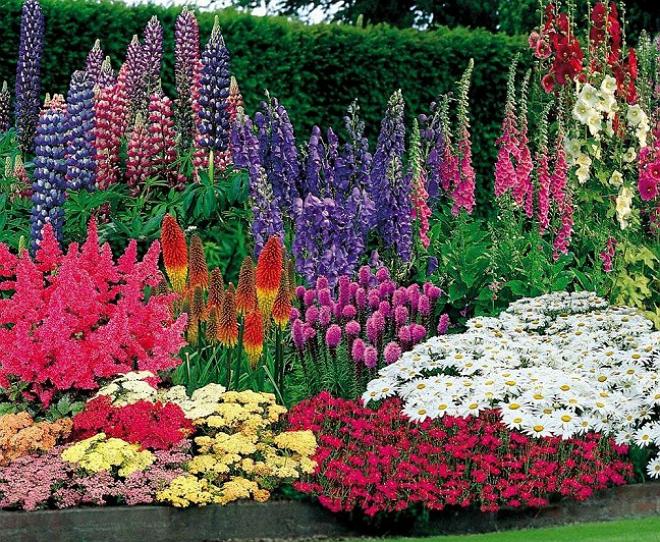

The shaded areas of the summer cottage will be decorated with flower beds with Japanese anemones, stonecrop, hosts of all kinds of colors of flowers and leaves, ferns, common primrose and dark geranium. A summer cottage with acidic soil is a great place to decorate a flower garden with hydrangea, rhododendron, fern. The flower bed scheme can also include herbal cloves, heather, canadian dogwood, broom or bergamis.
- Harmony emanates from the scheme of the flower bed near the house, consisting of virginia, rose, sedum, balsam, woolly and Chinese miscanthus.


- The decoration of any path will be a flower bed, the scheme of which includes a plantarium, coreopsis, petunia, creeping tenacious:
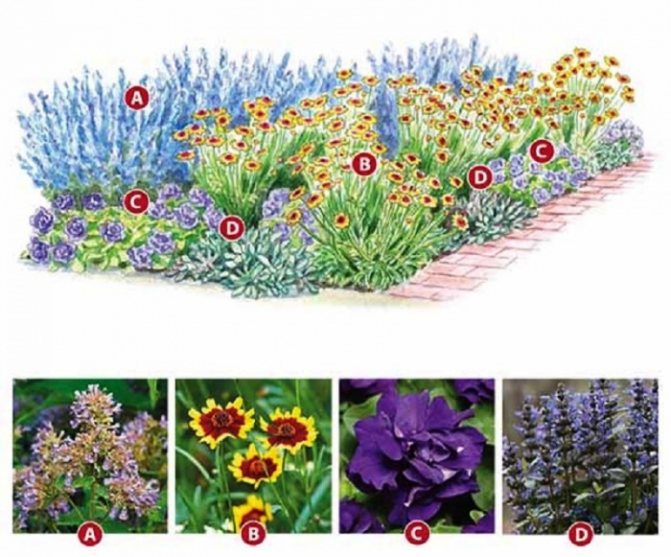

Reproduction of hydrangea
Like other perennial shrubs, hydrangea can be propagated vegetatively (by cuttings, dividing the bush, layering) and seeds.
To grow shrubs from cuttings, it is necessary to cut the tops of young non-lignified shoots in mid-July and root them in specially prepared soil, consisting of coarse sand and peat. Experts recommend taking measures to increase soil moisture under the cuttings. For this, sphagnum moss is added to it. Cuttings are planted in such soil a little at an angle, at a small (up to 5 cm) distance and provide them with a temperature regime in the range of 16-20 ° C. For rooting, 4-5 weeks are enough. After that, the hydrangea is planted in a permanent growing area and provided with proper care.
When the hydrangea propagates by dividing the bush, part of it is separated, while it is important that there are 2-3 buds on the young shoots, they are dug up and transplanted to a new place.
For the propagation of hydrangeas by layering, it is necessary to bend one of the young shoots of the growing bush to the ground and dig it into a previously dug hole (up to 15-20 cm deep). To prevent the shoot from straightening, it can be fixed with staples.Experienced gardeners recommend making an incision on the part of the shoot that will be in the ground to speed up the rooting process. It is necessary to regularly water the branch, it can also be mulched. After the formation of its own root system at the branch, it is separated from the mother bush and planted in a new place.
Why hydrangea is popular for landscaping garden
Garden hydrangea is a versatile plant. It has many advantages that make it irreplaceable in garden and park design. It is valued for:
- Long and colorful flowering;
- A variety of sizes and shapes;
- Unpretentiousness;
- Frost resistance;
- Durability.
In terms of brightness and variety of flowering shades, this shrub has no equal... Numerous plant varieties have a wide variety of inflorescence shades.
And some of them change the color of the flowers over time, giving the bush a very interesting and sophisticated look.
Garden hydrangea varieties vary in size. There are large plants up to 3 m high that look great in single plantings. But there are also smaller, as well as dwarf varieties, used for planting in groups and even for hedges.
Most varieties are quite unpretentious and do not require careful maintenance. And the bred frost-resistant varieties make it possible to plant this shrub even in areas with severe frosty winters.
You can find out more about the types of bush hydrangea here.
The life of the plant is considerable - several decades. And with proper care, it blooms profusely at any age.
Diseases and pests
As a rule, hydrangea is quite resistant to all sorts of pests and diseases. However, it can also become infected with chlorosis, downy mildew, spider mites, and green leaf aphids can appear on it.
Chlorosis is expressed in a sharp lightening of the leaves of the plant, the loss of their natural color. The reason for its development is the excess content of lime or humus in the soil. To eliminate chlorosis, it is enough to water the plant with solutions of nitric acid potassium and copper sulfate in turn with an interval of three days.
The cause of hydrangea disease with downy mildew is excess air humidity. For treatment, it is recommended to treat the hardwood surface with a solution of copper sulfate with the addition of soap.
Garlic infusion will help drive aphids from the plant. It is necessary to prepare a garlic infusion (200 g of chopped garlic in a bucket of water, let it brew for 2 days), add laundry soap (40 g) and irrigate the perennial with this infusion every 5-7 days until the aphids are destroyed.
Types of flower beds and choice of location
The place for the flower garden is determined based on its shape. A flower bed in the country can take on various shapes, the following types are most common:
- The flower border along the path is formed from undersized flowers.


- Rabatka is a rectangular flower bed decorated with plants of the same height.
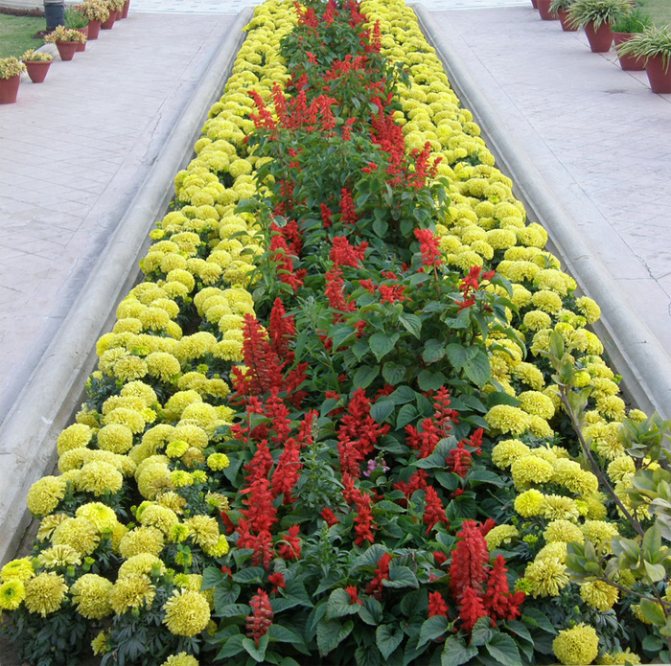

- Mixborder is a popular solution for decorating a summer residence in recent years. The arbitrary shape of the flower bed, coupled with plants of various heights, gives unlimited freedom of imagination when drawing up diagrams. Mixborder is a striking representative of continuous flowering beds, successfully forming a cozy atmosphere in the country.
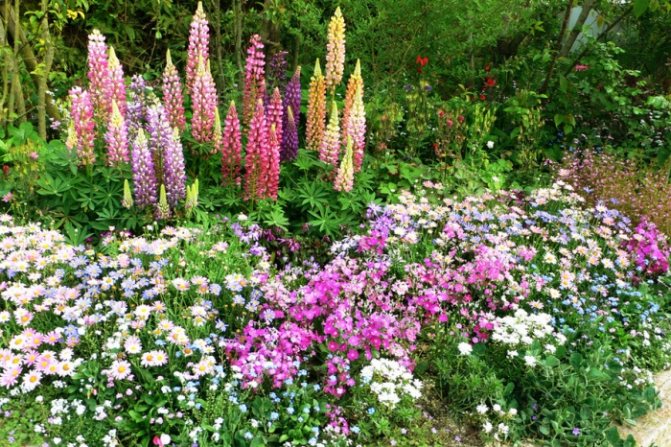

- Another leader among the variety of flower plantations is an alpine slide, a distinctive feature of which is the presence of stones in the design. Basically, it takes on a round or oval shape.
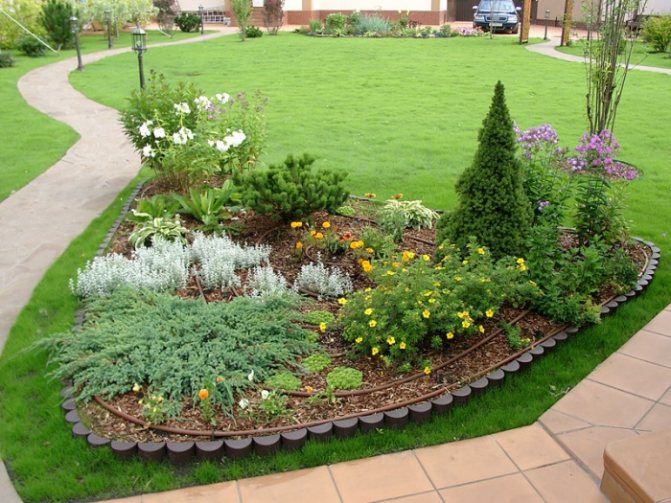

- Less common is a mono flower garden, consisting of one type of plant.
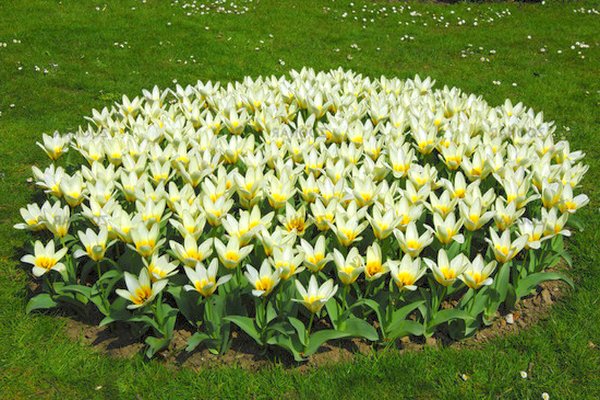

- The vertical flowerbed, which requires professional care, is distinguished by its originality.
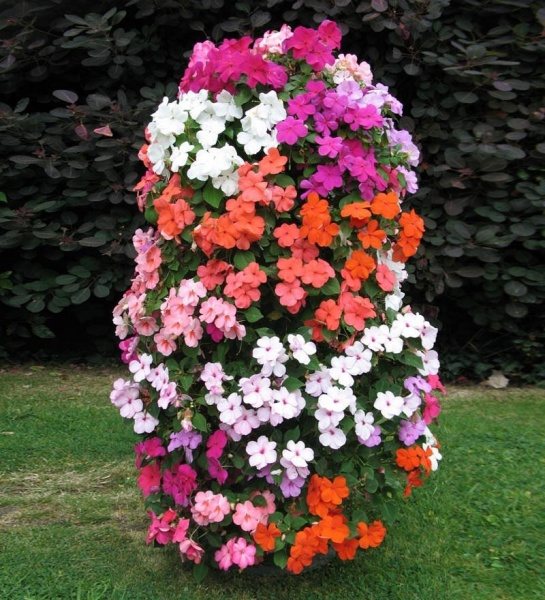

- Experienced gardeners should think about the formation of an arabesque in the country. The butterfly shape is the most common type of flower bed, which needs a planting scheme.


With a competent drawing up of a flower garden scheme, even primitive plantings can look spectacular and attract admiring glances.When choosing a flower bed scheme, it is preferable for beginners to stop at irregular flower beds, such as a mixborder or an alpine slide. The accumulated experience will allow in the future to start decorating regular flower beds at the dacha, where a strict geometric pattern is achieved by selecting plants with the same flowering time and observing a certain interval between planting.
To attract butterflies, a mixborder option from thuja, David's buddley, zinnia, goldenrod and purple echinacea will help.
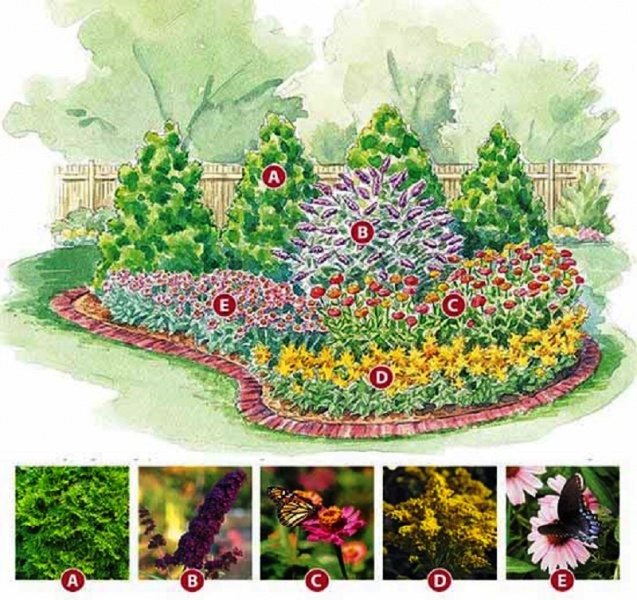

The optimal place for a flower garden is a plot that is well visible from all sides of the summer cottage. Multi-level plantings are usually arranged near walls or a fence, an arabesque flower bed will become an original decoration of the lawn, it is better for beginners to practice on an alpine slide.
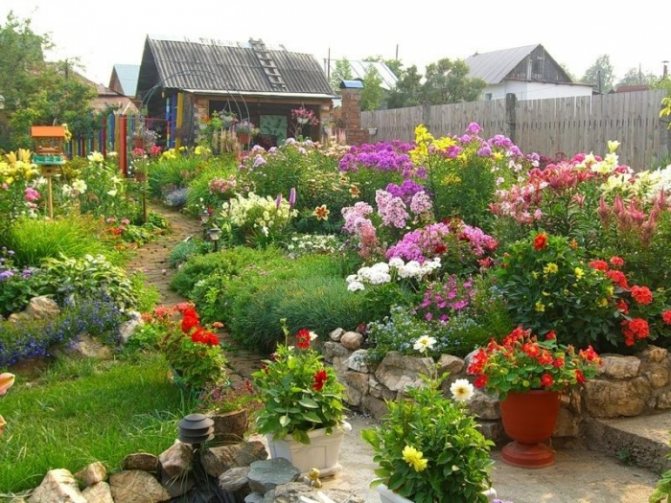

Hydrangea in landscape design
Hydrangea is a fantastically beautiful flower that inspires beautiful compositions in landscaping. Taking into account the climatic conditions, in our latitudes it is recommended to plant a tree-like, paniculate and petiolate hydrangea. Hydrangea looks magical in the photo in large compositions when it grows in the squares, surprising everyone with the size and beauty of its inflorescences. To emphasize the beauty of hydrangea, you can surround it with borders of spirits, cotoneaster, and other shrubs. The hydrangea should be planted in a flower garden in the background so that it does not obscure other plants.
It is not recommended to combine hydrangea with yellow, red, orange flowers. Plants with bluish flowers, needles or leaves can successfully shade a shrub - for example, clematis, cereals, hosts, low-growing junipers. A classic landscape design is the combination of hydrangea with pink phlox with a round shape of inflorescences, thujas, microbiota. Also hydrangea is used in mixborders to create compositions along garden paths, can be grown as a hedge.
Hydrangea is the foundation of a beautiful garden. With proper care, it will delight you for years to come. Experiment with different varieties of this shrub, try to decorate your gazebo with a climbing hydrangea, plant a tree-like one along the paths, create a living fence using a paniculata.
In patios and buckets or flowerpots
Combine hydrangea with conifers. For example, the Anabel tree variety, with its white delicate flowers, emphasizes their juicy greenery.
In order not to worry about the safety of the flower in frosts, you can plant it in beautiful flowerpots and decorate the corners of the garden with them. For this, any varieties of large-leaved hydrangea are suitable.
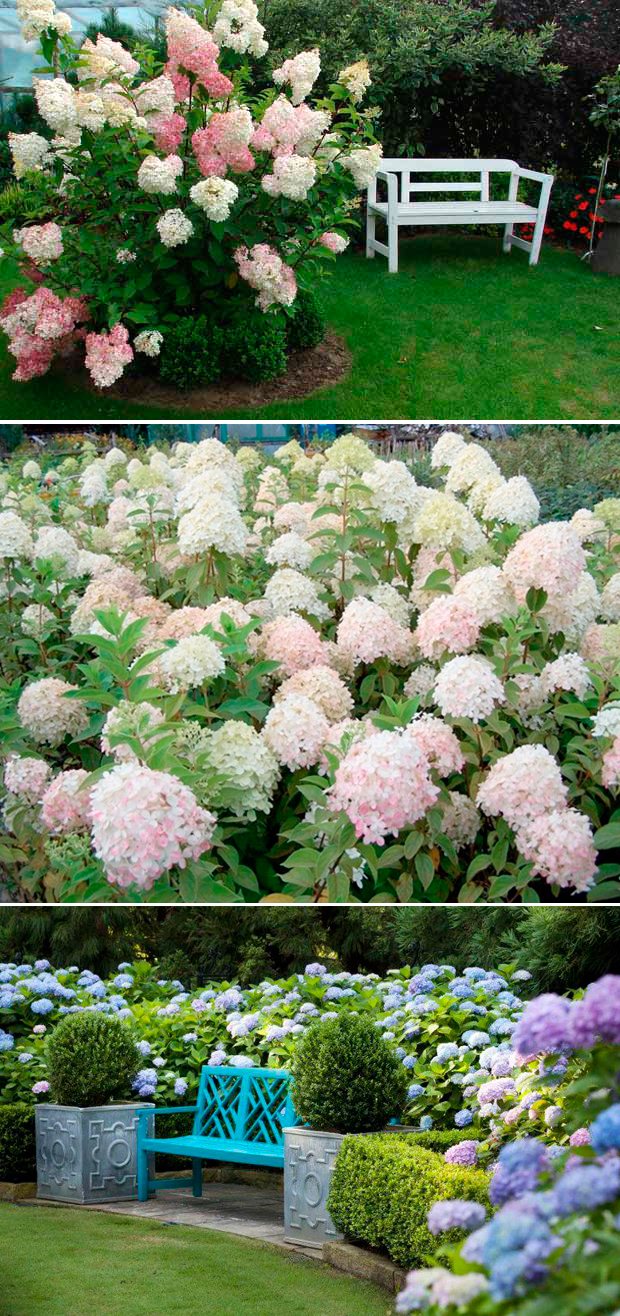

Panicle hydrangea varieties Vanilla Frize, Phantom, and Large-leaved
Garden hydrangea: photo
Let the fans of languid lush roses and other charming flowers forgive me, but there can be only one more hydrangea better than a hydrangea in a summer cottage. Growing hydrangeas in the garden is an artistic creative process when you feel yourself as the Creator of the Garden of Eden and the Creator of His Majesty Beauty.
A huge variety of the most unusual in shape and color varieties allows you to create a whole ensemble of a rainbow of bright colors and gentle tints. But closer to practice. Growing this plant is a snap.
The name of hydrangea is translated from Greek as "a vessel for moisture", the plant received this name for the unusual shape of the seed bolls, as well as for its love for moist nutritious soil.
General recommendations for planting plants
Before planting in a flower garden, seedlings need preliminary watering in 2-3 hours. The optimal landing time in the country is the absence of a bright sun, that is, in the early morning or at the end of the day. Better yet, choose a period before the rain. A flower garden of a round shape is filled from the center to the edges, a flower bed located near the fence of a summer cottage or building begins to be decorated from the background according to the chosen scheme.
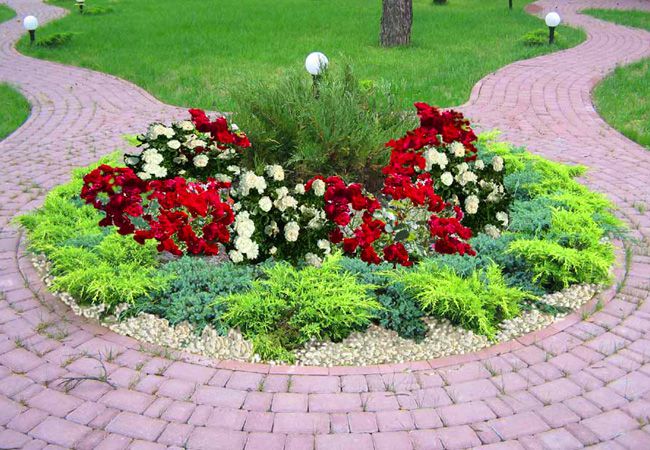

The roots of the seedlings are straightened, after deepening, the soil near the neck of the plant is compacted.Upon completion of the work, the flower garden is abundantly watered, tall weak seedlings are propped up with a stick. If a flower does not take root, it can be replaced at any time with a new copy from a pot. Do not expect the perfect appearance of a perennial flower garden in the country in the first year of the breakdown.
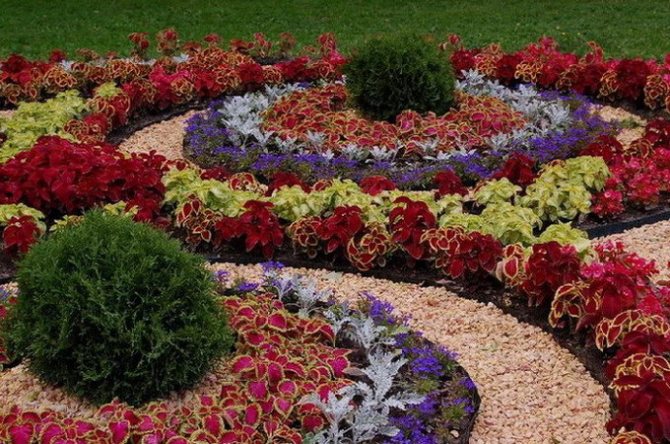

A fragrant flower garden made of hibiscus, kufei, penstemon, vatnik and petunia looks interesting, the diagram of which is given below:
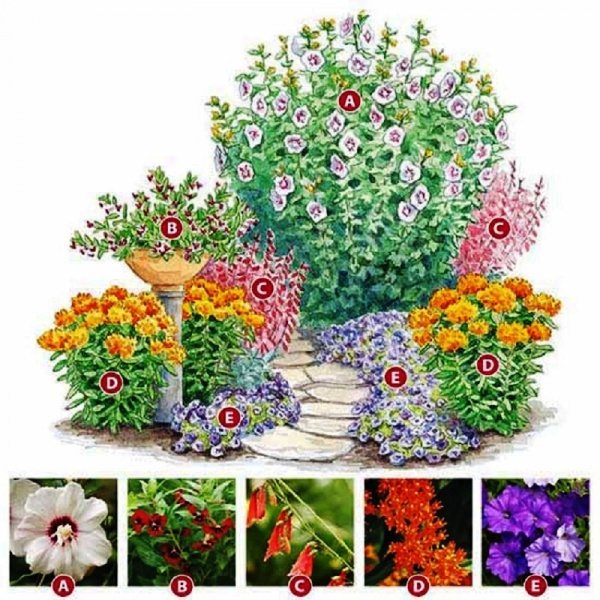

Do not be afraid to make adjustments to the existing flower bed scheme. Replacing one type with another, similar in content, changing the shape or area is only welcome.
Which variety to choose
A huge number of varieties of shapes and colors allows you to create a dream garden of paradise, which does not require painstaking care and pleases the whole season with exuberant flowering. Each variety is great in its own way, but combining them is an exciting activity, for which six acres may not be enough. How to grow a hydrangea in the garden is not difficult, it is important to choose the right variety.
Consider the most popular varieties of this amazing shrub that do well in central Russia:
- Garden large-leaved - for the winter in regions with winter temperatures below 10 degrees, it requires shelter. The bushes reach a height of two and a half meters, the leaves are oval, slightly pointed. Inflorescences in the form of large bright balls of pink, blue, greenish or variegated color, slightly flattened, which gives them a special charm. The most popular frost-resistant varieties: Quadricolor (yellow-cream pastel), Grandiflora and Perfect (with creamy inflorescences and spectacular shiny strong stems), Altona (loves shady areas of the garden, where it pleases with large pink bunches of flowers);
- Paniculata is an interesting species, bred by breeders relatively recently. Ideal for an Asian and Mediterranean garden with elongated, bright panicle-like blooms. Panicle hydrangeas in garden design are often used to decorate unsightly hedges or to decorate a small pond, since the height of the plants can reach two meters in favorable conditions. The most popular varieties are Sargent, Unicum and White Moss (blooms until the first frost);
- Tree-like - resembles an ordinary viburnum and is formed into a spectacular low tree with a snowy, creamy color. The most popular variety, Anabel, is resistant to low winter temperatures and pleases with bright colors from July to the end of September. It looks interesting as the main accent when decorating a landscape in a Mediterranean style;
- Serrated - a low, lush bush, with blue balls. Loves sunny, sheltered from the wind areas with moist nutrient soil;
- Sargent is an excellent honey plant. Planting and caring for a hydrangea in the garden of this particular species will lead to an abundance of bees on the site, this is worth paying attention to. The plant can reach a height of four meters, so tough autumn pruning is necessary;
- Pereshkovaya - ideal for vertical gardening, creating living flowering hedges and trellises. The design of a hydrangea in a garden of this type can be very unusual and varied - arches, decoration of the front entrance, shading of the veranda, or or a spectacular bent composition in the center of the flower garden;
- Dubolistnaya is a shrub with bright, beautiful foliage, acquiring a spectacular color closer to autumn (burgundy and purple). The only negative is that the color is only white, but the frost resistance is very high. The most cold-resistant variety Snow Flake;
Advice. When deciding on the choice of a variety, you need to pay attention to the average height of the plant and the width of the bush in order to create a correctly built landscape composition.
Landscaping styles and variety selection
- Leaf shape - large clawed, oval or with openwork edges.Large-leaved bushes look good in hedges or in the center of the composition as the main bright one. The oval shape of the leaf is more suitable for the decor in the Mediterranean style or in the spirit of the country style of northern European countries. Openwork foliage with thin veins will emphasize the sophistication and profundity of the Japanese garden style, and also remind you of Scandinavian evergreens;
- The shape of the inflorescences is a ball, umbrella, bump or panicle. The round shape is suitable for almost any garden design option, but the panicle hydrangea looks great in the borders for dry streams in the Japanese style or for the center of an alpine slide, in addition, these varieties are very fond of shady areas of the garden. Umbrellas or bunches of cones are more consistent with the climate and nature of Scandinavia and the North of Russia;
- The color scheme of these shrubs is extremely diverse - raspberry, purple, pastel pink and blue, bright purple and rich crimson, creamy white openwork scattering of inflorescences. There can be no advisers in this matter - the main thing is that the colors are harmoniously combined with each other. The price of a particular variety depends on many factors - terry inflorescences, unusual color and shape of the leaf, the latest developments in agricultural technology.
Advice. When choosing a variety, it is important to take into account that the color may differ from the declared one on different types of soil. Pink tones appear on alkaline soils, and blues on acidic soils. This fact does not apply to whites and creams.
Correct fit and proper care
Done right, lush bloom and delicious scent are guaranteed. But how to grow hydrangea in the garden? Let's start from the very beginning.
Having bought a bush in a store, it is important to find the optimal place for it on the site and choose a good soil mixture.
- The soil should have good air and moisture permeability, ideally loamy soils with an acidity of 7 to 4. If the soil is alkaline, then iron must be added to the nutrient feed during the entire flowering period;
- Mulching the near-trunk space with shavings, sawdust, coniferous needles or humus from the foliage helps to preserve moisture in the soil, and this bush is very picky about constant moisture, but not to its excess, otherwise the roots will rot;
- Growing and caring for hydrangeas in the garden is not that difficult, but some varieties can freeze in winter frosts. Therefore, a shelter made of plastic wrap, foliage and fabric is required.
Advice. In a small area, you can simply plant the bushes in tubs and bring them into a warm room for the winter.
- The optimal illumination for hydrangeas is diffused light or shade, but planting in sunny areas is also possible, depending on the variety. But in this case, it is important to organize regular irrigation, preferably drip in the near-stem circle;
- Do-it-yourself pruning or early spring before bud break or late fall. Tough root pruning is recommended for large plants;
Advice. Usually a ready-made bush is planted on the site, but you can propagate a hydrangea simply by bending and digging a branch for the winter, in the spring it will sprout roots and a full-fledged new bush of magnificent flowers will form.
Proper care of hydrangeas in the garden guarantees abundant flowering. But in some cases, novice gardeners are faced with a problem - a lot of dense foliage, but no flowers. Why doesn't our beauty bloom?
There may be several reasons:
- When pruning, it is necessary to leave several young buds at the ends of the branches - inflorescences will form here;
- The root system is underdeveloped. Sometimes the bush can bloom after three years, when the roots are fluffed up and gain strength;
- Very often, in northern latitudes, this bush does not have enough time to form flowers.
Advice. Buy varieties that are suitable for the planting region. Many of them delight in the first year with bright inflorescences, even in the north of Russia.
The principle of forming a flower garden
What to plant next to the hydrangea and in front of it "at the feet"
When organizing a flower garden with hydrangea, take into account the general principles:
- A plan is created on which the location of each flower is indicated.
- They study cultures: in what soil they grow, sun- or shade-loving (do not plant nearby), resistance to wind.
- Combination with each other: color of flowers and leaves, flowering period, do they get along side by side.
- They prepare the soil for different crops, clarify what fertilizers each plant needs.
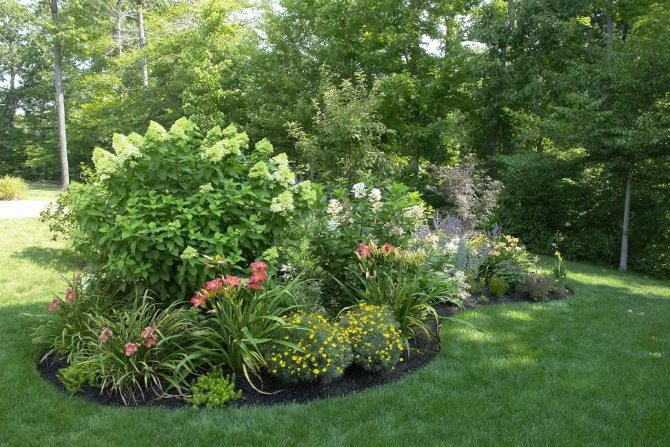

Hydrangea in a flower bed
When the flower bed is supposed to be admired from one side, it is placed along the fence or curb. Hydrangea is planted in the background.
If the review is from all sides, then it is located in the center.
Flowerbed with hydrangea and hosts
Hydrangea is a versatile flower. It is appreciated for stable decorativeness, bright foliage, pastel colors. It is planted separately and in groups, mixed with evergreen and deciduous crops.
Long and colorful flowering, various forms of inflorescences, unpretentious care - all this makes the flower irreplaceable in garden design. One of the advantages important for central and northern Russia is its frost resistance. The culture has been growing in one place for many years. Around and around it, varieties and types of flowers change, so every year the garden looks different.
For reference: a composition with a hydrangea in the garden looks good when plants with contrasting texture and texture are planted in the company.
These include hosts. Perennial flowers, they are suitable for hydrangeas in terms of growing conditions: both love partial shade, suffer from direct rays. They are settled in shady and damp corners of the garden.
Hydrangea, surrounded by hosts, looks impressive. They accentuate her style. This group gives the garden character and personality.
Hydrangea and coniferous compositions
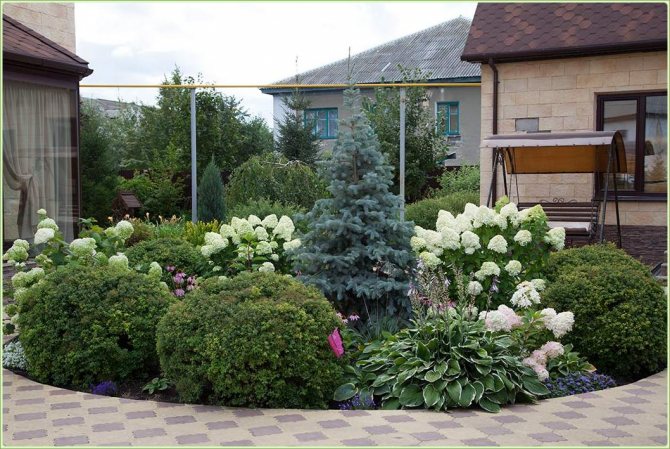

Hydrangea with conifers
The flower is varied in varieties. They differ in size, bush shape, color of inflorescences.
But in garden design, the leading place belongs to panicle hydrangea. It is placed singly, used in a group planting, or in a hedge. For "lonely" species with spreading crowns are suitable. To be conspicuous, they are planted away from trees. In this case, they work on the shape of the bush, pruning they achieve the ideal proportion.
Helpful information: Although the shrub is genetically tuned for a graceful configuration, the crop is helped by pruning and pinching the shoots. A perfectly formed bush attracts attention not only at the time of flowering, but also at other times.
Once the hydrangea was planted only in flowering hedges. Now there is a fashionable and practical trend to plant hydrangea in a flower garden where you need to create catchy and expressive accents.
Hydrangeas can be perfectly combined with conifers. For example, thuja Smaragd is in the center of the composition. Its lower branches lie on the ground. An evergreen tree with bright needles becomes the backdrop for a blooming hydrangea. The need for sun and moisture are the same, so they get along well.
The narrow pyramidal shape contrasts beautifully with the spherical hydrangea bush. Any garden with coniferous compositions and panicle hydrangea wins in terms of simplicity and originality of the solution.
Thuja Amber Glow is a representative of conifers, which is also combined with hydrangea. It is a dwarf plant, well below the hydrangea. Looks like golden balls. This thuja is planted in front of the hydrangea.
The neighborhood of thuja with its neat crown and hydrangea emphasizes the well-groomed garden. It's good when birches, barberries, maples, bird cherry, lilacs are in the background. It will be unsuccessful to plant a "purple sun", as the hydrangea is called in Japan, against the background of a pine tree with long needles.
Combination with woody plants
Due to its excellent appearance, the ability to grow in sunny areas, this culture goes well with almost any vegetation in the garden, both decorative deciduous and decorative blooming.


Planting under a tree looks spectacular and protects the hydrangea from the bright midday sun
A beautiful compact bush with lush pale pink inflorescences can be used in several variations.
- A colorful and variegated combination is obtained when planting in a flower garden along with spirea, mock orange, lilac, which are often the decoration of sunny corners of the garden.Long-flowering hydrangeas enliven and create an extraordinary contrast with their inflorescences for the monochromatic greenery of previously faded shrubs.
- You can plant paniculate hydrangeas with cotoneaster, juniper and boxwood. The result is a bright and spectacular hedge.
- Planting next to fruit trees will be a good combination. The lush blooming shrub will easily tolerate such shading and will embellish the garden with additional colors and greenery.
- In late autumn, when almost all flowers on flower beds and flower beds are blooming, panicle hydrangea continues to delight with its grace and colors against the background of evergreen thujas, junipers, and fir.
- For garden paths, planting in combination with barberry surrounded by perennial grasses would be an excellent solution.
Choosing the best location
Hydrangea tolerates some shading well, grows well in penumbra... Like any aristocrat, she does not tolerate exposure to direct sunlight. Choose a slightly shaded area that is most brightly lit in the morning.
Keep in mind that an adult hydrangea bush, taking into account branches and flowers, takes about 1.5 m in diameter.
The soil for hydrangea should beloose, nutritious in composition, with a predominantly acidic environment. An alkaline environment is categorically unsuitable for hydrangeas - theylime is contraindicated.
The ideal option ismature compostcontaining many nutrients.
Bad and good neighbors
Not worth it place hydrangea next to plants with a shallow root system, since, due to similar environmental requirements, they will oppress each other. Do not plant hydrangeas under trees - powerful tree roots take all moisture from the soil.
Better Neighborhood for hydrangeas, these are plants with fleshy roots or tubers. Hydrangea is very good adjacent to hosts, astilba, looks beautiful in combination with boxwood.
Option 2. The flower garden is in the shade and surrounded by paths
In the shade, it is usually necessary to plant plants that do not thrive in direct sunlight or prefer moist soil. Shade-tolerant hosta, badan, geranium, thuja, irises, horizontal juniper correspond to these conditions.
Moreover, it is necessary to correctly arrange the plants in height. Knowing that hosts, incense and geraniums grow up to 30-40 cm, they are planted in the foreground. Closer to the middle of the flower garden, taller plants are placed: thymus spherical, larch on a trunk, irises, daylilies, aquilegia.
It should be remembered that shade-loving plants please, as a rule, not with flowering, but with their delicate and juicy foliage or needles. Therefore, shady flower beds are more monochromatic.
The main rules for creating a flower garden
Thus, when creating a flower garden on the site, you must follow 4 rules for planting plants.
- Determine whether the flower bed will be in the shade or in the light.
- Choose plants based on the conditions of maintenance (soil moisture, access to light).
- Choose crops with different flowering periods.
- Distribute the plants according to the "ladder" principle: from the lowest at the edge of the flower bed to the highest in the background.
We have given examples of successful flower beds for different areas of the site. Try to repeat them or bring your ideas to life. Happy landing!
Hydrangea is a leader in landscape design. I appreciate this culture for its long flowering and decorative effect. Consider the popular varieties and rules for composing compositions.
Neighborhood with flowers of different types
The shrub goes well not only with tree-like, perennial plants, but also decorative deciduous and brightly flowering crops in the garden. It is readily used to create an unusual and original composition in mixborders.
Paniculata varieties
If you are thinking with what flowers it is better to plant a hydrangea, remember that in a flower garden this ornamental shrub culture goes well with roses, clematis, and lilies.In this combination, the bush performs an additional function of a hedge.
On a sunny rabatka, you can create a composition of panicle hydrangea surrounded by delphiniums, multifilament grasses, paniculate phlox or autumn anemones.


Rabat with hydrangea will decorate the path in the garden
Panicle hydrangeas look good near artificial reservoirs. In such a place, they are the highlight of the overall composition against the background of decorative deciduous crops. For a spectacular combination, several cultures will become the best neighbors - hosta, astilba, badan. Even after the colorful shrub has faded, the composition remains beautiful and variegated, thanks to the varied shape and color of the leaves. Ferns, heucheras, cuffs, buzulniks, bruners and rogers will be a beautiful addition. Such flowers with bright and variegated leaves look colorful and excellent.
Tree varieties
For a tree hydrangea, which has not only lush, but also bright inflorescences of different shades, plants with a more modest look are suitable.
A good combination will turn out when planting together with a perennial hosta, snow-white or pale pink astilbe, astrantia.
For lovers of bright and contrasting colors, a combination of blue flowers of a tree hydrangea with bright red astilbe inflorescences is suitable.
A combination of a tree-like culture with tall stonecrop, aconites, paniculata phlox and muzzle will be successful.
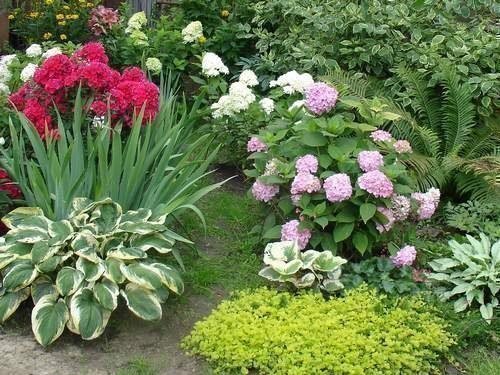

A successful combination - hydrangea bushes with plants of different levels
There are many variations of the combination of panicle hydrangea in the garden. The main thing is, when planting, take into account all the requirements of each plant for the composition of the soil, moisture, space in order to avoid competition. Otherwise, the decorativeness and beauty of such a composition will not be fully revealed.
A brief history of the emergence of culture
Excavations in different parts of the world confirm that hydrangea appeared on the earth millions of years ago. Initially, it grew in the region of North America, and later migrated to Asia. The hydrangea (Hydrangea) got its Latin name due to the structure of the seed capsule, which looks like a vessel for water.
The plant appeared in the gardens of Europe only in the 18th century, it was brought here from North America by D. Bartram, who was keen on botany. It was a treelike hydrangea species. Soon another botanist, K. Peter Thunberg, was sent to the Japanese islands for seeds of large-leaved hydrangea, which he managed to get with great difficulty. So new plant species began to spread in Europe.
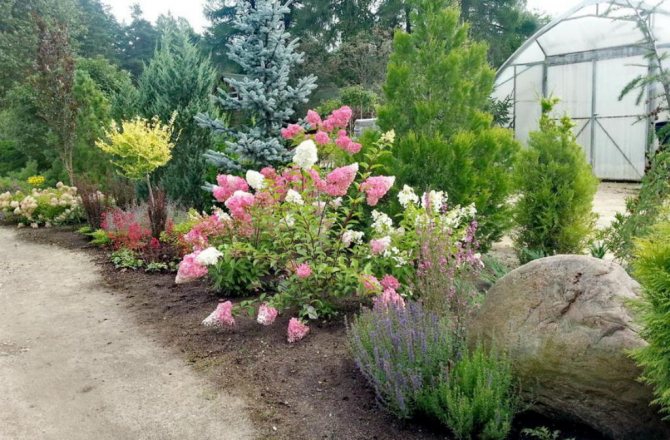

Hydrangeas in landscape design
Half a century later, the German scientist F. von Siebold procured and brought several varieties of this culture unknown to European botanists, including the panicle hydrangea.
For your information! At first, the plant was not often used in the landscaping of gardens in Europe. Real popularity came to him at the beginning of the XX century. after the next botanical exhibition. This was the beginning of a widespread culture in many countries where hydrangea is still popular.
Option 4. A flower bed separating the recreation area from the garden
Typically, these flower beds are located in a sunny spot in the middle of the site. In such a composition, plants are planted, the height of which reaches no more than 2-3 m. This is necessary so that they do not create a large shadow.
In early spring, the flower garden is decorated with conifers: junipers, spherical and pyramidal thuja (for example, the vertical is emphasized by the pyramidal thuja Smaragd). Closer to summer, the baton is intercepted by the viburnum-leaved Luteus and irises, and groundcover roses, hydrangeas and alpine carnations are responsible for summer flowering.
Drawing up flower beds
Hydrangeas go well with many things in the garden. For flower beds, low-growing varieties of hydrangea with narrow foliage and inflorescences of different shades are best suited.The plan for a flower garden on a personal plot should be planned in advance. What can be planted next to a hydrangea? If the design of the garden is in the English style, you can plant it on a flower bed with geraniums and various ornamental grasses. On a site designed in a rustic style, when creating a flower bed, watering cans, buckets, cans, in which you can plant a hydrangea, will be appropriate.
You can also arrange for planting in a wooden box. Wooden benches and a table, a well, a gazebo will harmoniously fit into such a design. Ferns perfectly complement the hydrangea in the flower bed. Stylistically, they are equal partners and can create amazing ensembles, colors and textures, producing an equally noble impression.
Note! Compositions of hydrangeas, roses and hosts in the garden look beautiful. Due to the variety of colors, the hosts will be able to emphasize all the advantages of the majestic shrubs. Cereals unexpectedly look in the company with hydrangea: miscanthus, millet, chanonekloa. Such a duet looks simply luxurious, despite the seeming incongruity.
If we consider flowering crops, plants of light shades are most suitable for hydrangeas: astilbe, anemones, unpredictable physostegia, paniculate phlox. The inflorescences do not have to be white, you can use a contrasting, bright color, achieving the perfect combination. Daylilies, primrose irises and daffodils can all serve as graceful frames for a luxurious hydrangea bush.
When choosing plants for a garden in which hydrangea plays a leading role, you should support the overall concept of the landscape being created. It is imperative to take into account the flowering time so that the site looks great throughout the season. Today hydrangeas remain fashionable, in demand and irreplaceable, and the variety of varieties allows you to find "your" plant, with which you will definitely be able to make friends.
Adding an article to a new collection
Almost every owner of a suburban area dreams of a wonderful flower garden that would delight with its flowering throughout the warm period. How can this be achieved?
The list of plants for a flower bed directly depends on its location. Let's take a look at the main sites on the site where you can arrange a flower garden, and consider which plants are suitable for their design.
Planting scheme for hydrangea paniculata
Astilba - what to plant next to
Considering the size of the plant, the duration, brightness and splendor of flowering, hydrangea often becomes the dominant in the composition. If the flower garden is clearly visible from all sides, the bush is planted in the center. In the flower garden near the fence - in the background.
Interesting. Hydrangea flowers do not have an expressive smell, therefore, they are not attractive to insects, they can be safely planted near windows, paths, gazebos or terraces.


Hydrangea near the house
When using hydrangea in garden design, some care features must be taken into account:
- The flower loves partial shade, diffused sunlight. Do not plant a bush in a sunny, leeward place.
- Hydrangea needs regular watering. In order for the roots not to rot, it is necessary to use drainage in the form of rubble or gravel when planting. Mulching with needles or sawdust will help retain moisture longer.
- The plant grows well in acidic loose soils, but does not tolerate alkaline clay soil.
Important! The color of the inflorescences depends on the acidity of the soil: the more acidic the soil, the brighter and richer the color. You can increase the acidity with aluminum chips, chelated fertilizers or citric acid solution.
Principles of flower garden formation:
- Choosing a place. The flower garden should be a decoration of the garden, attract attention. Therefore, the site is selected clearly visible, but slightly shaded.
- A scheme is being thought over.In order for the flowerbed to blend harmoniously with the surroundings, it must correspond to the size of the garden, be combined with the overall design and concept. It is best to first draw a diagram of the flower garden on paper, mark the diagram with pegs on the ground.
- Prepare the soil. One of the key points is light fertile soil, which is the foundation for future abundant flowering. The site is dug up, weeds are removed, sand, humus, ash are introduced, everything is thoroughly mixed and watered abundantly.
Advice! In order to prevent the edges of the flower bed from overgrowing with grass and weeds very quickly, the flower garden should be fenced off with stones or covered with agrofibre around the perimeter, on which gravel or broken brick can be poured.
Competent selection of plants
Using hydrangea in a flower garden, you must adhere to the basic rules for planting flowers:
- Tall flowers and bushes are planted in the center: hydrangea, rose, daylily, delphinium, peony, iris, gladiolus. Gradually the level decreases: tulips, daffodils, zinnias, marigolds, violets, petunias. Ground cover plants will help to fill in empty areas and complete the composition: periwinkle, herbal carnation, lungwort.
- The period and timing of flowering of each culture are taken into account - the flowers must be placed in the flower bed in such a way as to achieve harmonious flowering throughout the season. Herbaceous plants will help to complete the picture: hosts, ferns, red fescue.
- Think over the color scheme of the flower bed. A combination of contrasting, bright shades is possible: blue, yellow, red, white, green. More restrained noble designs are often used in one palette. White flower beds look good. Red shades (from rich burgundy and wine to pale pink), yellow (from orange and to lemon and pale yellow) are interestingly revealed.
Considering all the nuances of growing, the best option for combining with hydrangea are:
- Trees and bushes - rhododendron, barberry, viburnum, conifers (thuja, pine).
- Bulbous - tulips, daffodils, daylilies, crocuses, hyacinths.
- Perennials - rose, astilba, phlox, geranium, anemone.
- Annuals - marigolds, pansies, gerberas, dahlias, petunias.
- Herbaceous plants - ferns, hosts, mint, wormwood, periwinkle.


Combining hydrangea with other flowers
The composition with hydrangea in the garden should be combined with the general theme: the design of the house and the backyard area. Several design options are popular:
- Country style. To create it, bright colors and plants are used that resemble a rural garden: meadow (chamomile, thyme, cornflower, wormwood), annuals (marigolds, violets, zinnias, Carpathian bells), herbaceous (periwinkle, mint, ivy, ornamental cabbage), trees ( viburnum, willow).
- Classic style. Suitable for decorating a plot in a modern, discreet design. This option involves a combination of hydrangeas and conifers, roses, ferns or host, ornamental onions, petunias.
- Japanese style. A fashionable trend in landscape design is the creation of a Japanese garden. To design it, you need a small fountain or trickle, which is complemented by rhododendron, fan maple, fern and moss. Low-growing chrysanthemums will add brightness to the composition.
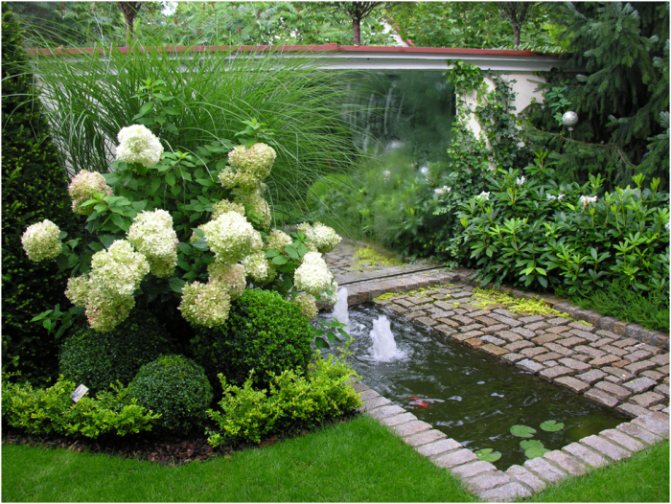

Japanese-style hydrangea
Important! When creating a scheme for a flower bed with hydrangea, it is very important to maintain a balance and choose plants that will match the mixborder in size - too large crops in a small flower bed will seem inappropriate, small ones in a large flower garden will be lost.
Compositions with hydrangea in the garden
There are several options for combining hydrangea with other plants, which are always win-win and effective.
A flower bed with hydrangeas and hosts is a classic combination that is striking in its simplicity and style. The luscious greenery of the host favorably sets off the delicate bloom of the hydrangea.The variety of colors of both cultures allows you to create original and beautiful compositions. In addition, both hydrangea and hosta love shaded areas and retain their attractive appearance for a long time. Caring for such a flower garden is extremely simple.
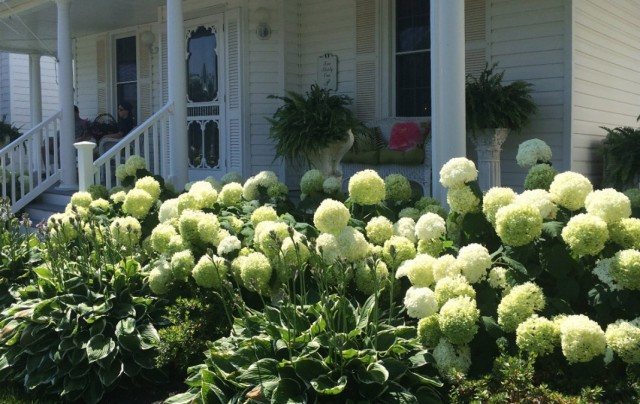

Hydrangea with hosts
Hydrangea and coniferous compositions are the optimal combination. Ephedra oxidize the soil, which is so necessary for hydrangeas. In addition, flowers against the background of rich coniferous greenery seem even more beautiful and graceful. Hydrangea looks good in tandem with spruce, juniper, fir, pine. You can complement the composition with roses or ferns.
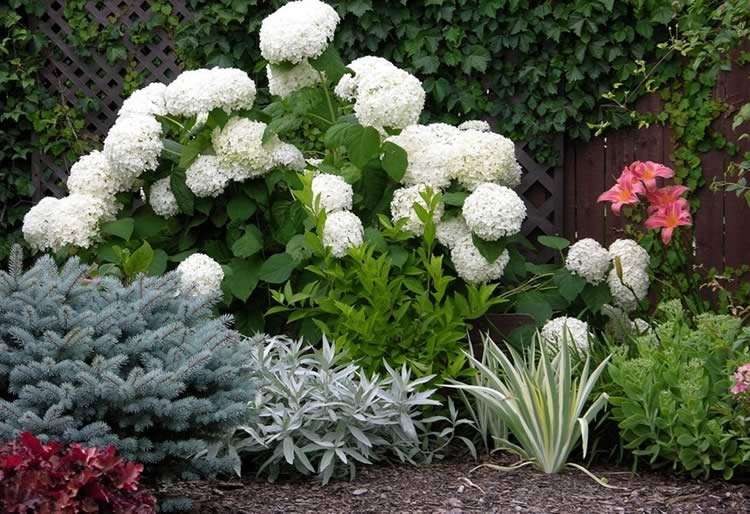

Hydrangea and conifers
Option 5. Flower garden at the entrance to the site
The flowerbed at the entrance to the backyard area should be the brightest and most impressive. Here is an example of such a flower garden:
The year-round whitish-blue needles of the dwarf spruce Glauka Globoza will not leave anyone indifferent. In contrast to it, it is worth planting a green horizontal juniper. The spring season in the flower garden is opened by the Nippon Snowmouth spirea, then the cinquefoil, Japanese spiraea, euphorbia, Douglas spiraea and tree hydrangea bloom. Heuchera also brings a certain color to the flower garden - all thanks to its bright red foliage.
Neighbors for hydrangeas


Hydrangeas are in demand and loved by many. Shrubs are used for landscaping and decorating not only urban areas, but also private gardens. Gardeners prefer to use hydrangeas due to their stable flowering, unusual color and bright foliage. It is possible to plant both individual hydrangea bushes and a huge flower bed, consisting of a similar multi-colored splendor. The possibility of creating unusual and stylish combinations speaks in favor of hydrangeas. They differ in a variety of colors that can be combined if desired.


Also used to create lush and catchy flower beds, gradually replacing the practical and previously applicable trends for planting plants exclusively in groups. With the right care, even one bush can help create the right atmosphere in a small but neat flower bed. Shrubs can be used to create hedges, but the subsequent maintenance of a green hedge requires free time and regular maintenance. Hydrangeas are often used to improve the area near lawns, undergrowth, forest edges, hedges. The ability to combine with low-growing trees, shrubs and conifers made the hydrangea in demand in this area.
Hydrangeas will also decorate a plot or garden when arranging shrubs with other skeletal plants and giants. You should not be afraid of small plants, the flowering period of which does not coincide with the hydrangea. The plant is combined with herbaceous flora. Perennials are often planted in close proximity to hydrangeas. A skillful combination of shrubs and other plants will help to cope with such primary tasks:
A flower bed along a fence or wall
When decorating a flower bed along a fence or wall, you should also follow the rules for planting plants in the form of a "ladder". Therefore, undersized shrubs or flowers are planted in the foreground.
In the above diagram, Japanese spirea and ground cover roses are placed closer to the edge of the flower garden. It is no coincidence that a juniper is planted between them, it serves as a dividing layer between two shrubs blooming at the same time.
To give the flower garden a more solemn look and create the effect of symmetry in it, tall plants with a pyramidal crown are planted along the fence. The basis of this composition is made up of panicle hydrangea bushes located in the center. The white summer flowering of the hydrangea is supported by the pale pink candle-shaped inflorescences of the Douglas spirea, the symmetry is emphasized by the pyramidal thuja beautifully standing on both sides of the flower garden. Delphinium sets the color in the autumn period and with its height enhances the effect of "striving upward".
Comfortable growth conditions
All types of hydrangeas, including paniculata, are sun-loving plants that prefer to grow in an area with access to natural light, but the ability to shade at midday. Such a condition is necessary in order to preserve the decorativeness of foliage and large, colorful inflorescences from the harmful effects of sunlight.
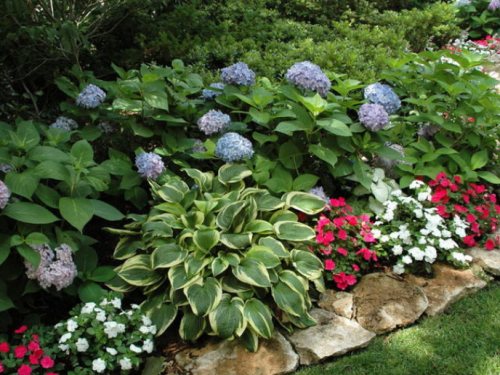

Hydrangea in the shade with hosta and balsams
When choosing a place in the garden, you should think over everything to the smallest detail.
- Hydrangea paniculata does not like stagnant moisture, so a wetland is not the best site for growing it. The optimum groundwater depth is at least 1.5 m.
- Also, a colorful shrub does not grow well on acidified soil, therefore, before planting, the soil must be deacidified - by 1 sq. m. add 350 g of calcite, chalk, slaked lime or dolomite flour. Then carry out a deep digging and leveling.
- It does not tolerate strong winds, from which the soil dries out quickly, and behind it the roots of hydrangea. Choose an area protected from drafts - you can plant it near the walls of the house, along the fence.
- A high decorative effect for a shrub in any composition will be provided by a fertile soil, therefore, it is advisable to sprinkle the place before planting with compost or rotted manure - 10 kg per 1 sq. m.
Care during the season
Watering. Remember that a hydrangea is a "container of water": provide abundant irrigation, ideally drip. Several buckets of water should fall under each plant per week, by no means tap water - only rain or settled. To prevent the soil from drying out, mulch the near-trunk circle with peat, needles, sawdust with tree bark, sprinkle the mulch with a layer of 20-25 cm.
Pruning. Throughout the summer, remove inflorescences that have faded and dried up - this will give the plant the opportunity to extend the flowering period. Perform rejuvenating pruning in the spring - remove shoots that are frozen after severe cold, as well as branches that are more than three years old. After the buds awaken, correct the result - cut off the shoots with unblown buds. In order for the bush to be lush, cut off the shoots at 4-5 buds.
If you want to rejuvenate an old hydrangea bush, completely cut off all the shoots at the root in the fall, leaving only a small stump. In spring, a powerful root system will allow you to quickly grow a lush crown.
Top dressing. Water the hydrangea with water with organic fertilizer (humus, manure) dissolved in it two or three times a month. Do not overdo it with mineral fertilizers, their excess can adversely affect the winter hardiness of the plant. You cannot fertilize ash hydrangea.
When to transplant hydrangea?
If you want to transplant a hydrangea, follow the same rules and guidelines as when you first plant the plant. This is best done in early spring or fall after the end of the flowering period.
If your goal is not just to change the place for a beautiful bush, but reproductionhydrangea, the optimal technology would be the following:
- 1. Water the plant abundantly and allow the moisture to absorb.
- 2. Dig the hydrangea in a circle at a distance of 15 cm from the bush. It is more efficient to use a pitchfork for this.
- 3. Tilt the bush and use a sharp knife or shovel to separate part of it.
- 4. Disinfect the incision site with ash.
- 5. Transplant part of the bush into a previously prepared hole in a new location.
Take care of Princess Hydrangea at the time of planting, and this magnificent plant will thank you for its spectacular appearance, becoming a real pearl of your beautiful garden.
| Categories: | Flower garden / perennials |
Tags:
flower garden hydrangea
Cited 1 times Liked: 2 users
Garden hydrangea: planting and care, neighborhood in the garden
Monday, 03 October 2019 11:09 + in the quote pad
Garden hydrangea - the favorite of many gardeners. Attractive air caps of lush inflorescences of white, blue, pink, light green color add sophistication to any landscape.
To successfully plant and grow a hydrangea in your garden, you need to follow a few simple guidelines.
The optimal time to plant a garden hydrangea is Spring, after the threat of nocturnal freezing of the soil has passed, but before the buds began to bloom.
In regions with not very harsh winters autumn planting is acceptable, but here you need to be in time before the first frost.
It is recommended to plant cuttings of hydrangea only in the spring to give them the opportunity to root during the active season and gain strength before the next winter.
Planting and growing
Most hydrangea varieties need good lighting for flowering. It is better to choose a place where the plant can receive sun in the morning or evening hours. The midday heat can cause burns on the leaves. Any building or tall neighbors can become protection from the scorching sun. If hydrangea is used in the landscape, with which it is combined according to growing conditions, it should also be taken into account.
Important! Increased lighting requirements for Phantom, Endless Samme, Peppermint varieties.
The soil for these plants should be loose, but at the same time hold water well, sandy loam soil will not work for them. For high-quality flowering, the indicator of soil fertility is important, therefore, the cultivation of hydrangea requires fertilization. Top dressing begins to be introduced simultaneously with the beginning of the growing season, alternating organic and mineral.
All nutrients are supplied to the plant in liquid form. Superphosphate, potassium sulfate are used as top dressing. Nitrogen fertilizers need to be applied only in early spring, later they can enhance the growth of green mass to the detriment of flowering. It is important to provide the hydrangea with nutrients at the time of bud formation.
Important! Polar Beer, Limelight, White House and Endless Summe are especially demanding on soil fertility.
Most varieties of hydrangea require pruning, which can be done in spring or autumn, as the plant blooms on the shoots of this and last year. For paniculate and tree-like hydrangeas, pruning in the spring is more suitable, since their inflorescences are formed at the tops of new shoots. But the large-leaved hydrangea is cut in the fall, in the spring only frozen and dried shoots are removed.
Examples of harmonious flower beds
In conclusion, I would like to give a few more examples of flower beds for summer cottages of various levels of complexity.
The scheme of the simplest flower bed for teapots will decorate the dacha with a warm palette of pink, orange and red flowers, diluted with a purple tone. Arboreal heliotrope is planted in the background (1). Terry marigolds and Sander's tobacco form the middle tier (in the diagram, they are marked with numbers 3 and 2, respectively). The parterre of the flower garden is occupied by a stunted New Guinea balsam at number 4.


For an extensive mixborder flower garden you will need:
- Giant Pleniflora mallow.
- Ten-petal sunflower.
- Icelandic poppy.
- St. John's wort
- Lobelia cardinal.
- Fassen's Catman.
- Bell.
- Catananche "Blue Cupid"
- Avens
- Sedum Matron.
- Heichera Miracle.


The scheme of a flower garden, resembling a piece of cake in shape, must be prepared:
- The corner of the flower bed is filled with a daylily in the amount of 3 bushes.
- Under the number 2 are silvery wormwood leaves, 2 copies on each side.
- A dark red korostavnik is planted in the center, 6 pieces are enough.
- The edges of the flower garden are decorated with 3 heuchera bushes with burgundy leaves.
- On the front of the flower bed, there are 5 specimens of silvery leaves of the chisel.


The absence of a reservoir in the country can partially replace a flower bed, the scheme of which contains flowers of blue and blue shades. The stream bed is imitated by large blue colored pebbles. Glass balls will add transparency and dynamism. The flower garden is decorated with the following plantings:
- Bamboo leaf grate.
- Iris bearded.
- Lubelia.
- Creeping tenacious.
- Bell.
- Aubriet hybrid.
- Bruner large-leaved.
- The bryozoan is styloid.
- Creeping tenacious.
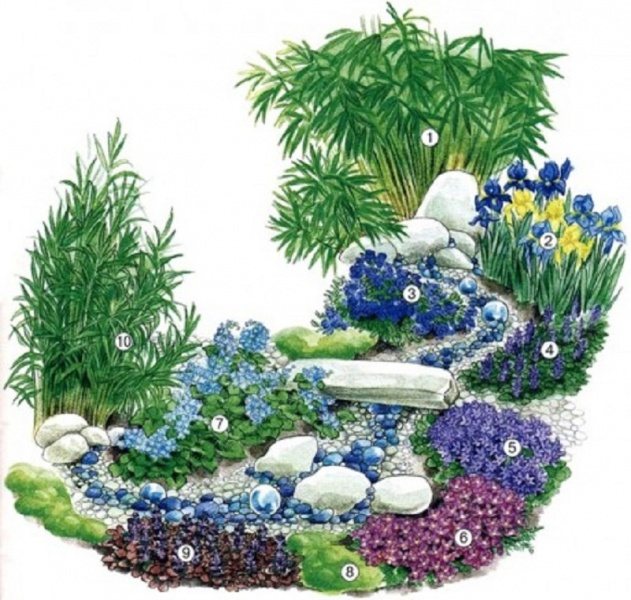

The proposed schemes are not an immutable postulate. Based on them, in the country you can create your own unique flower garden, pleasing to the eye throughout the warm season.
With good growing conditions and proper care, hydrangea (hydrangea) can bloom all summer. There are more than 70 species of this plant, and a huge number of varieties cannot even be enumerated. The bush is immortalized in a beautiful legend: a girl who fell in love with a brave warrior disappeared into thin air, leaving her beloved in memory of a flowering bush with pink inflorescences. Since then, people have been growing hydrangeas in different parts of the world.
Option 1. The flower garden is located in a sunny place along the path
It is more logical to arrange it so that it can be viewed from all sides. Therefore, in the center we place tall plants that grow up to 100-150 cm (delphinium, lupine, weigelu, daylily), and at the edges, relatively undersized perennial flowers and shrubs (Japanese spirea, heuchera, euphorbia, cinquefoil, cuff, cloves).
In addition, in order for the flower garden to be elegant from spring to autumn, it is necessary to take into account the timing of flowering. Lupine blooms on such a flower bed in May; in June and July - geychera, cuff, carnation, alpine, daylily; delphinium pleases in August.


